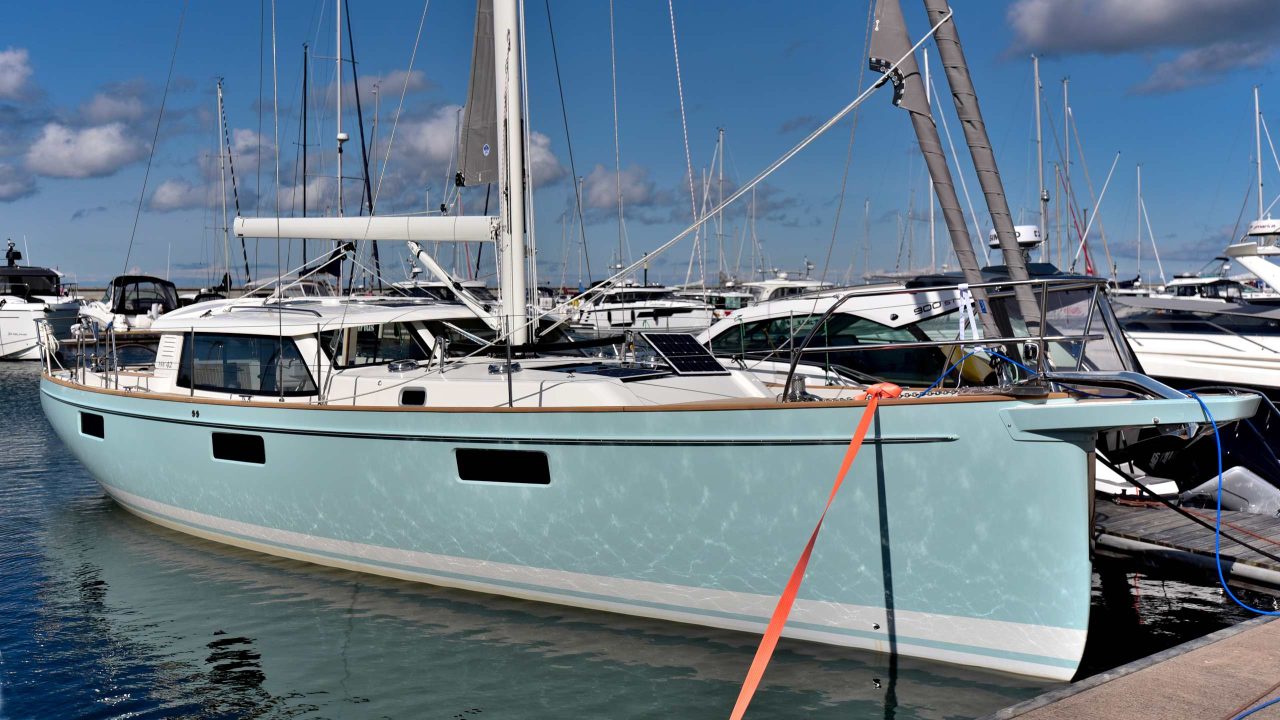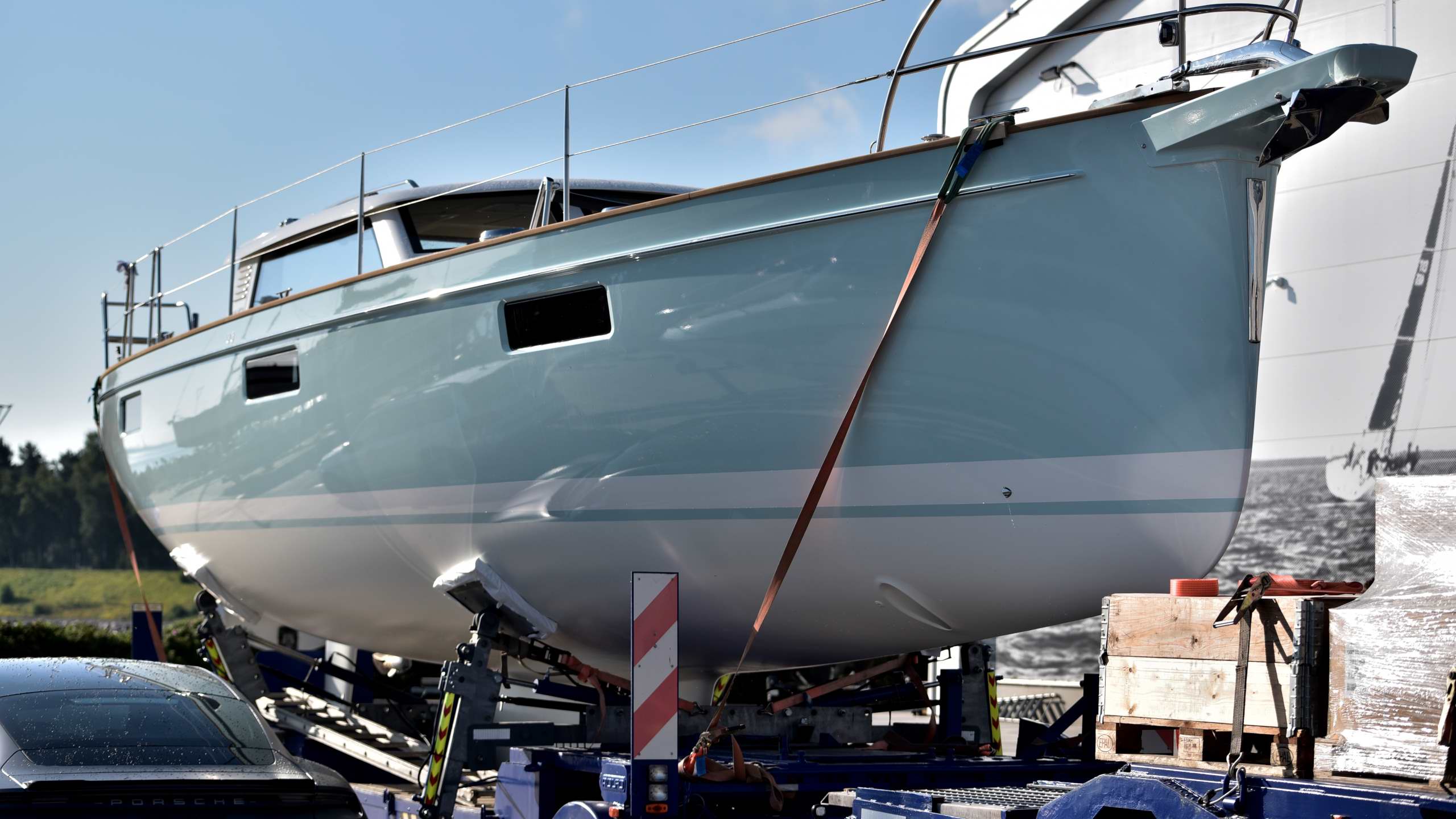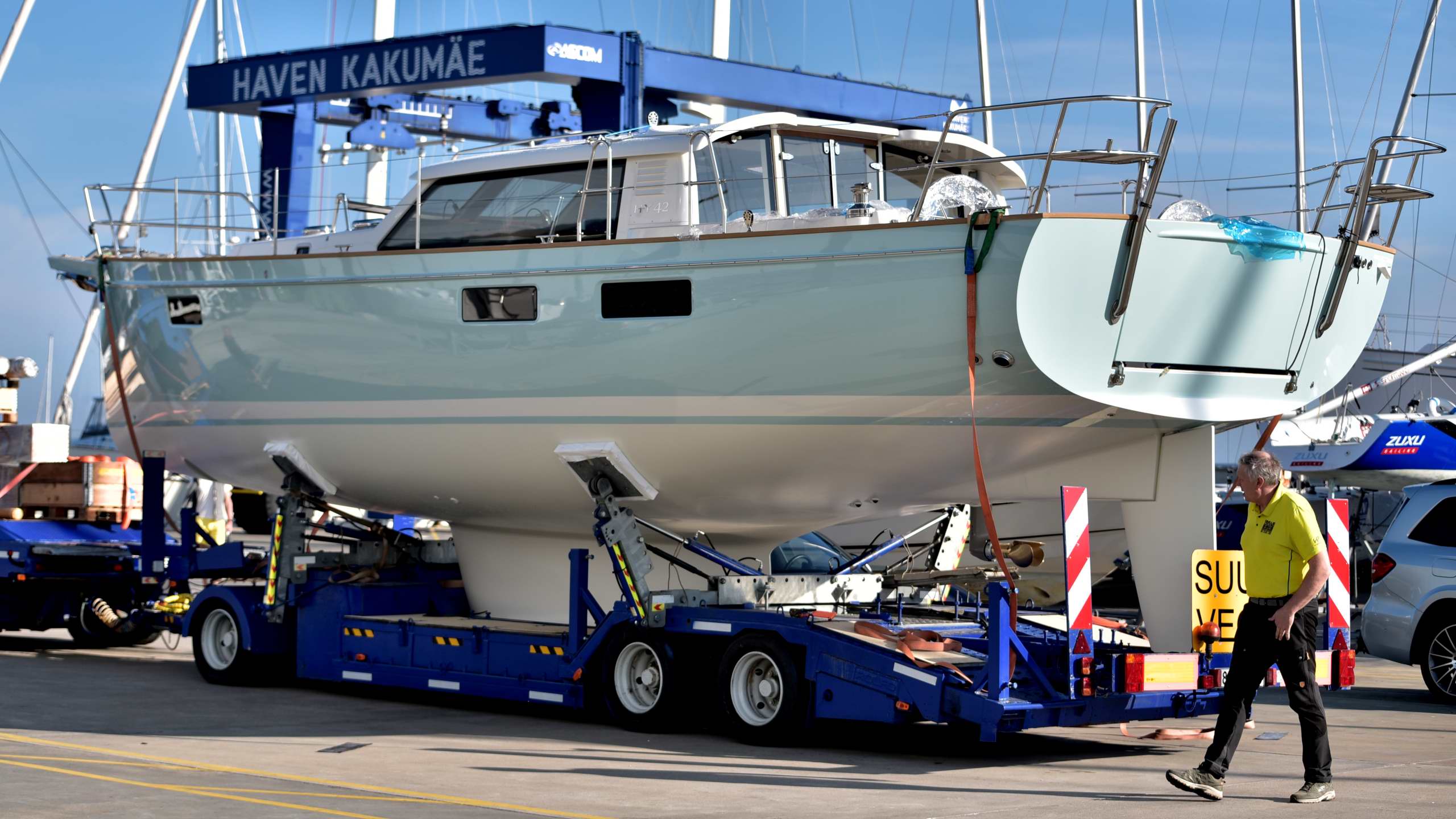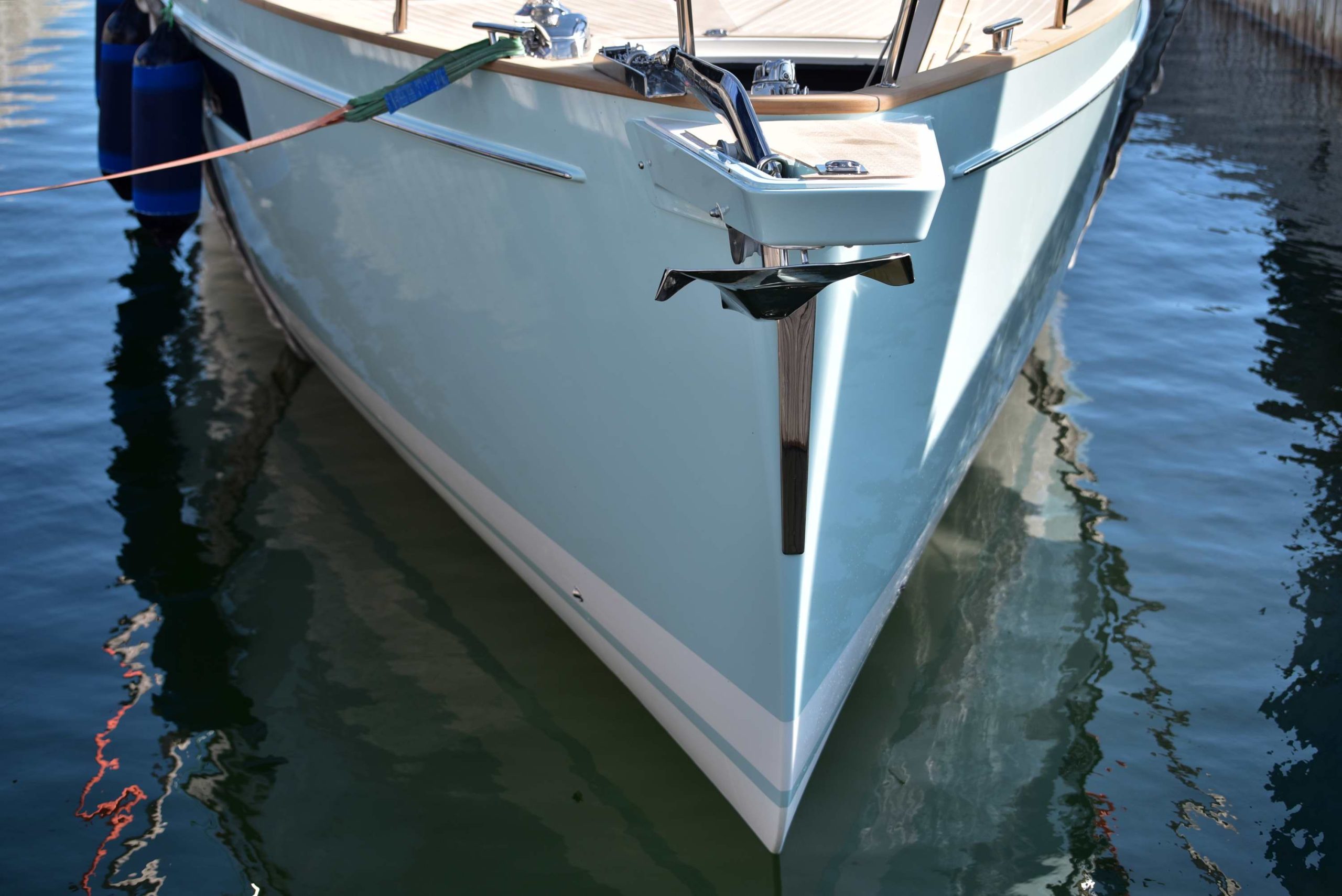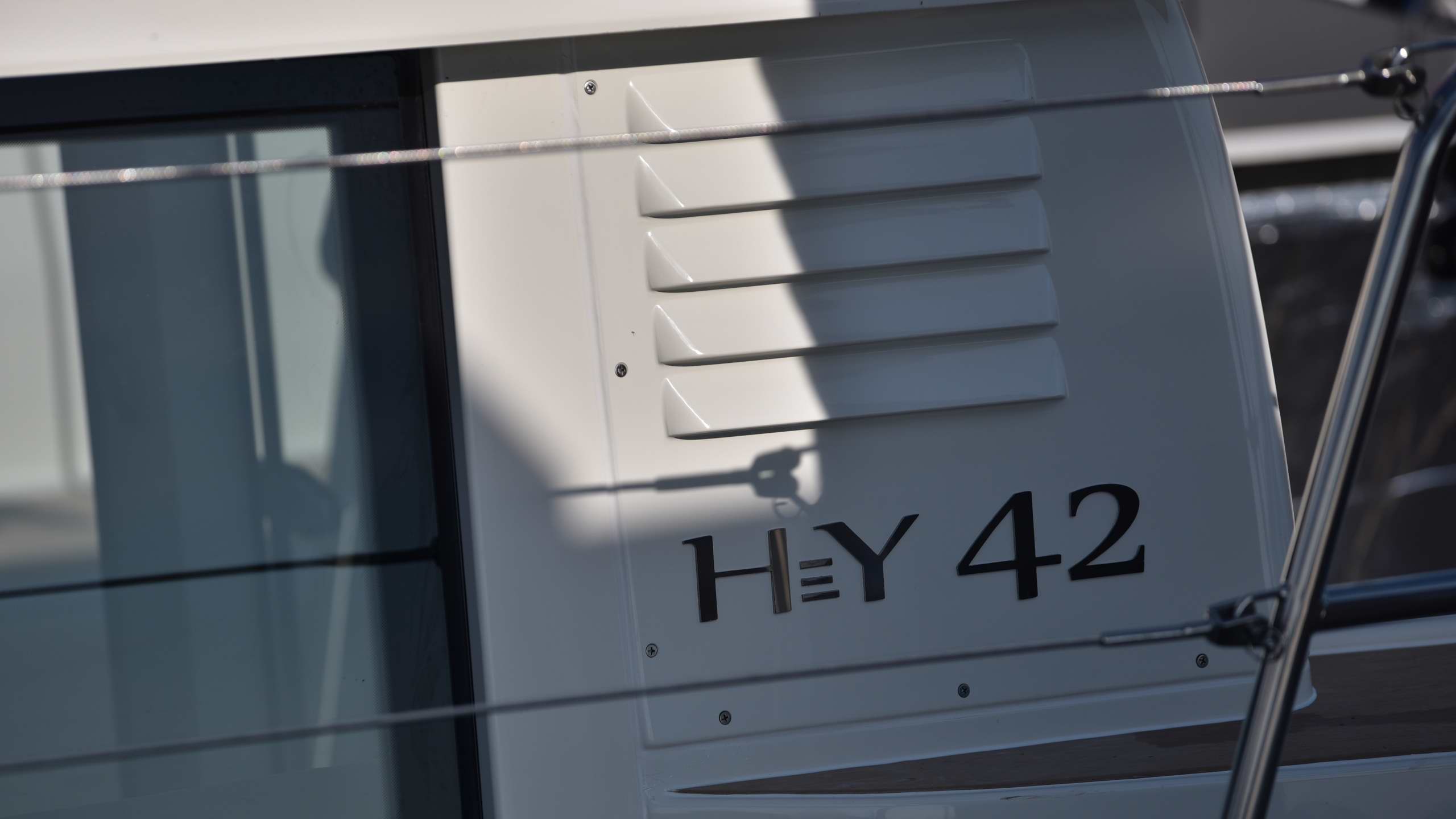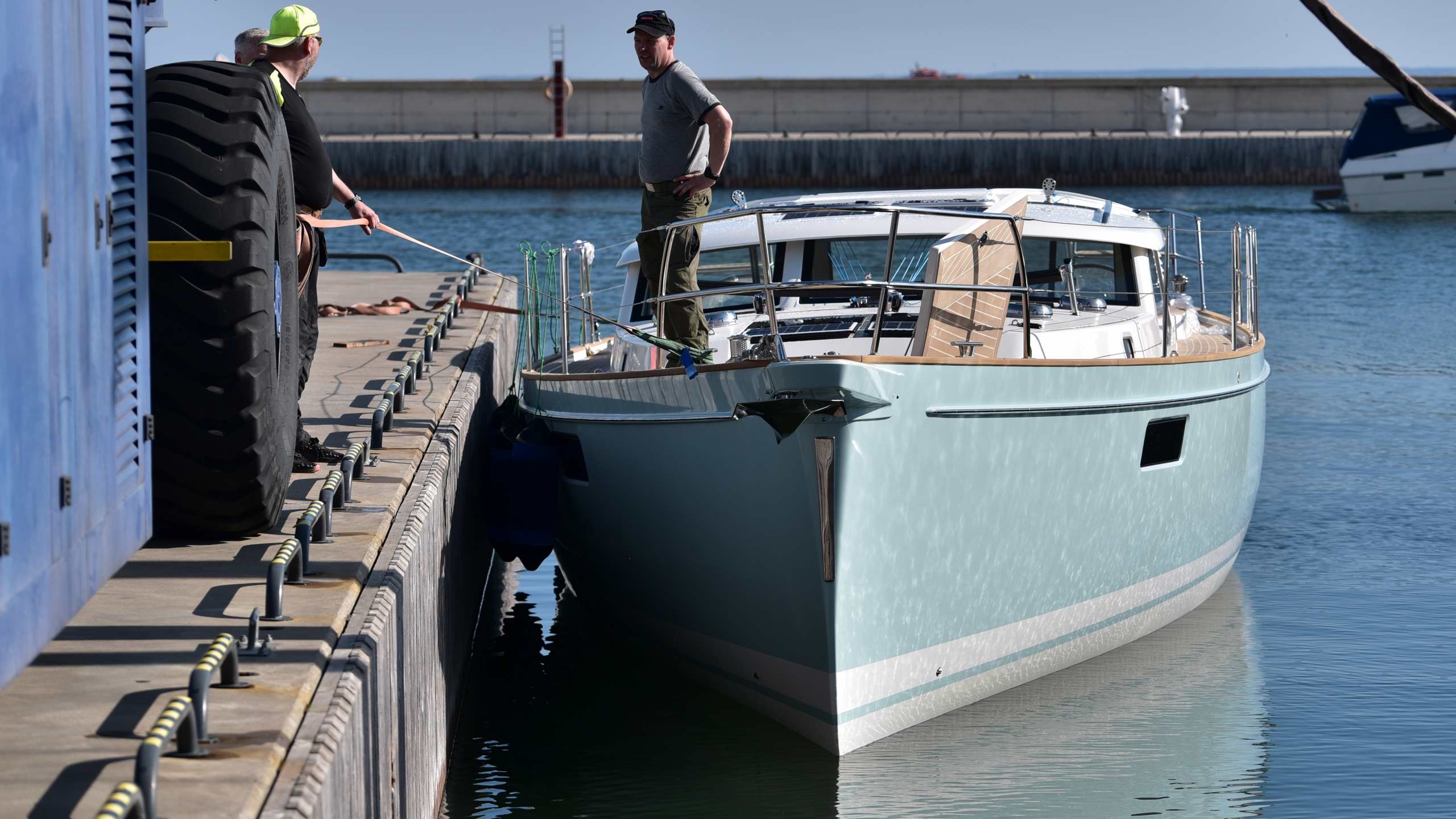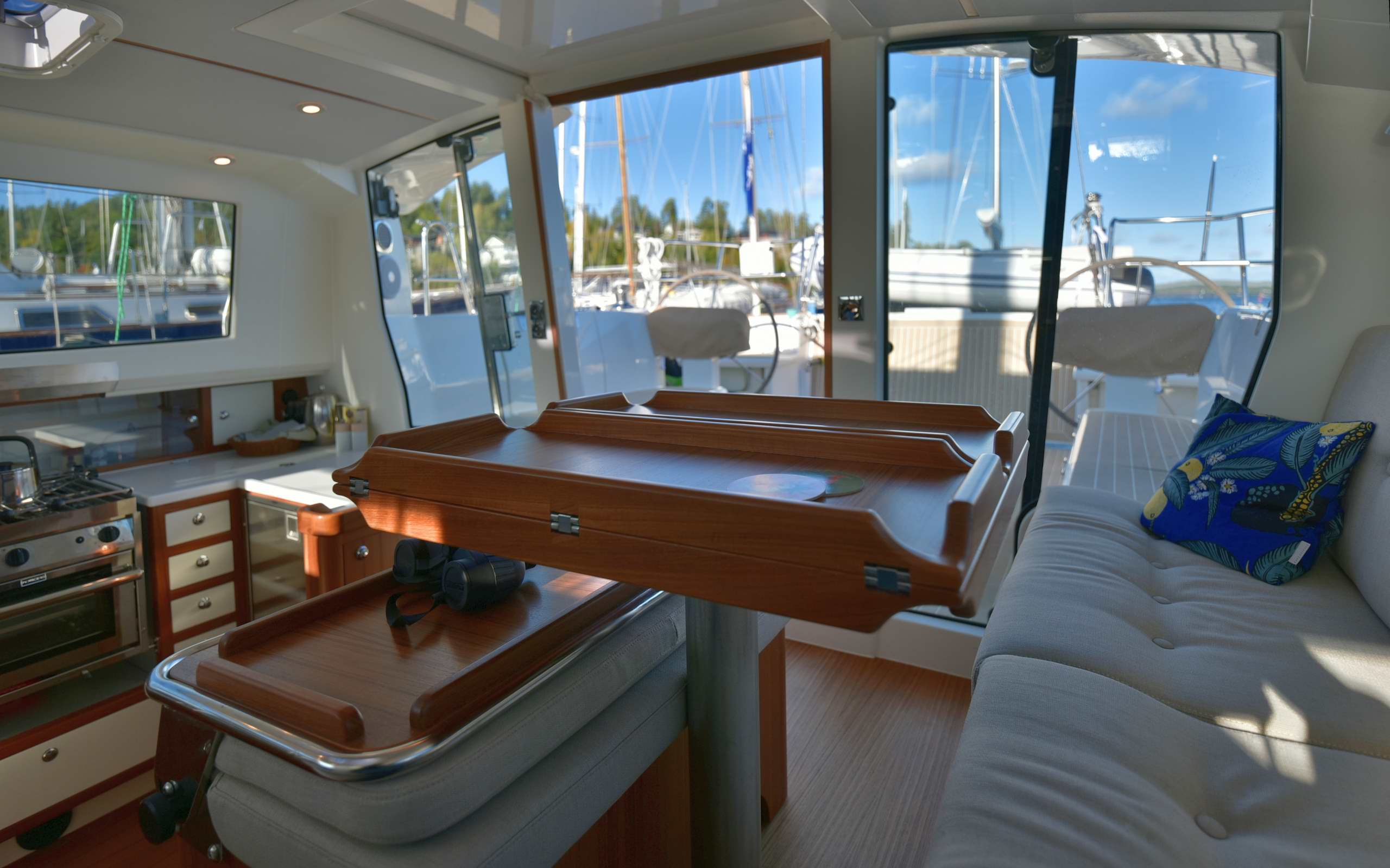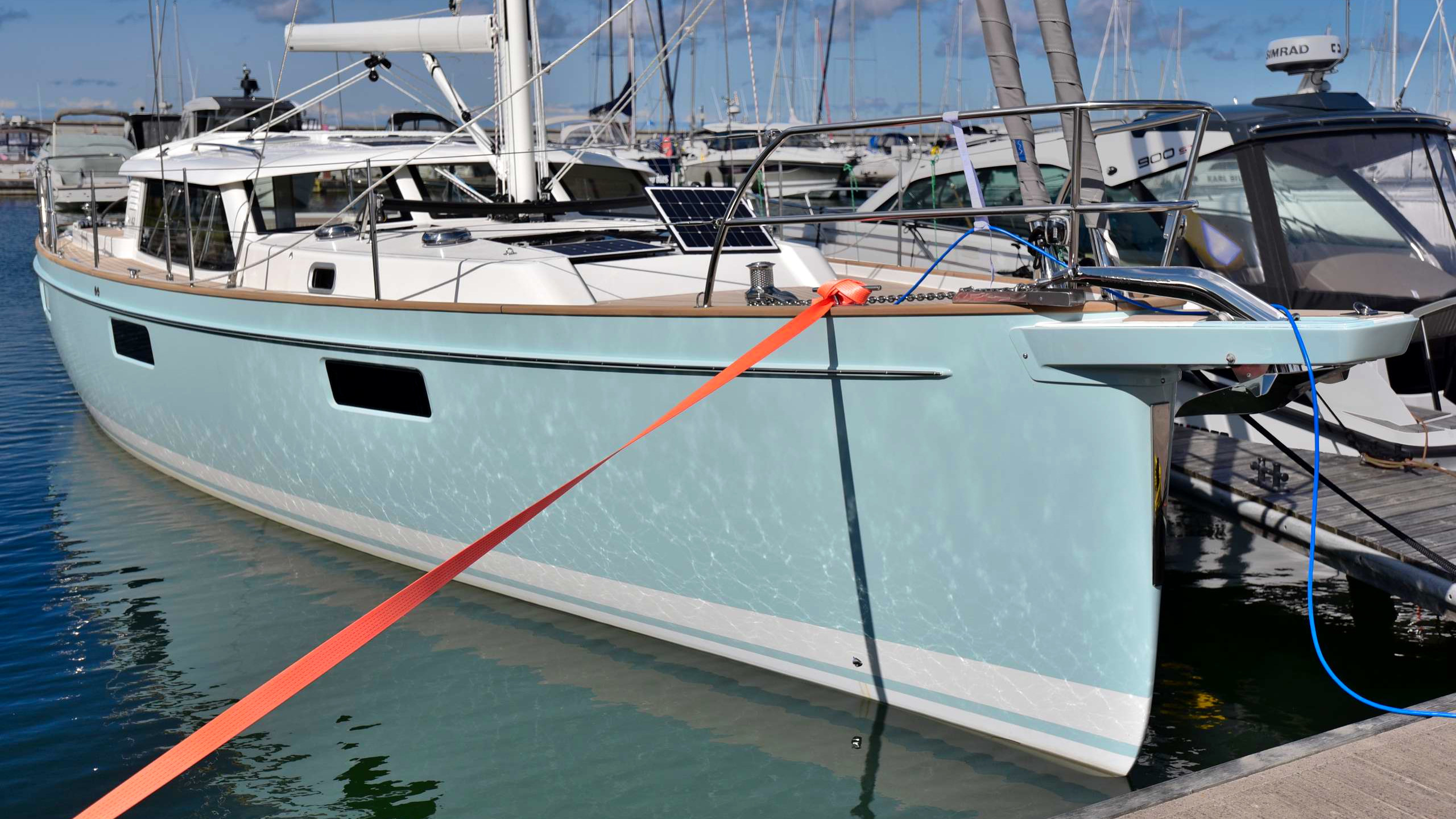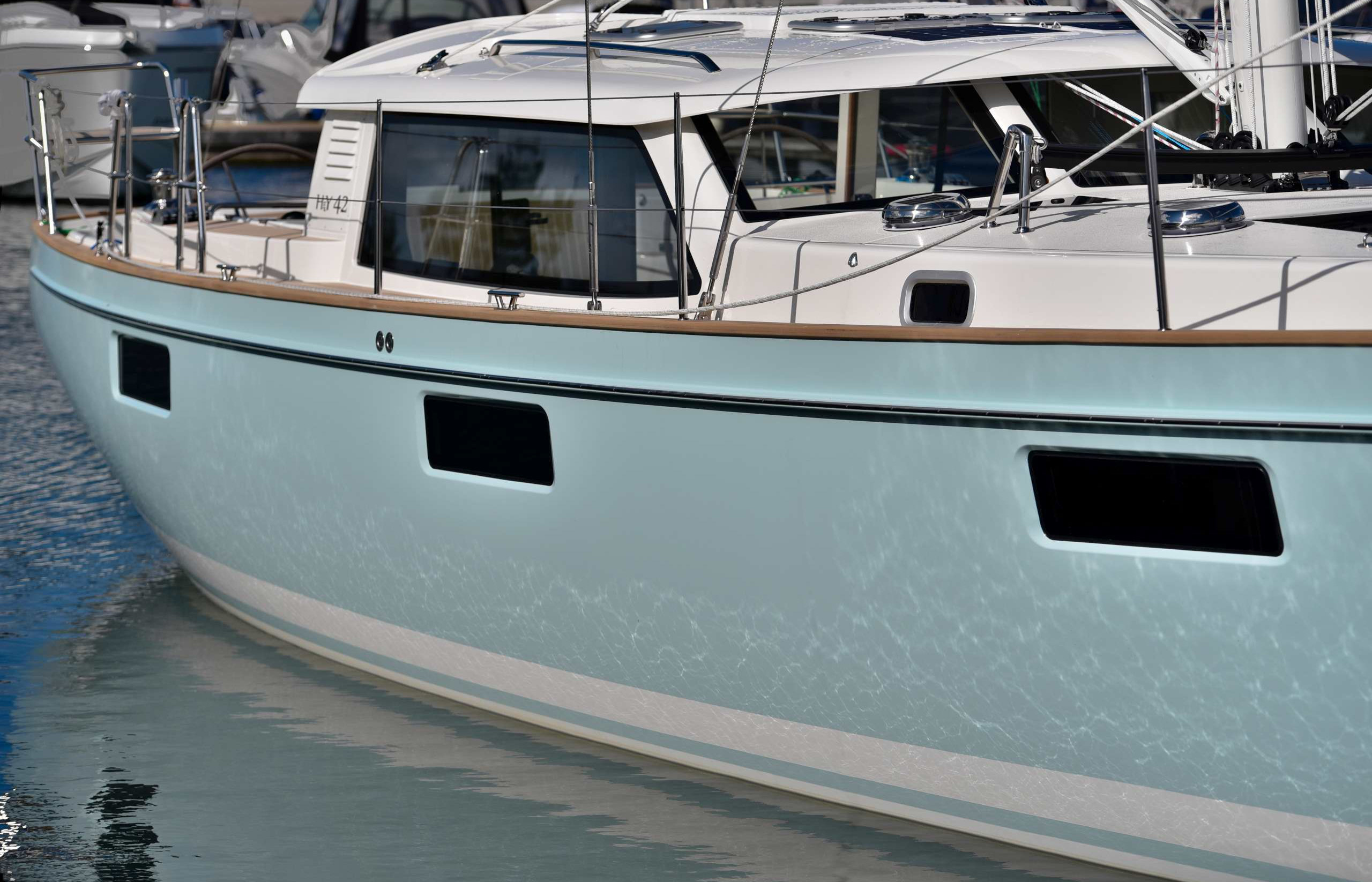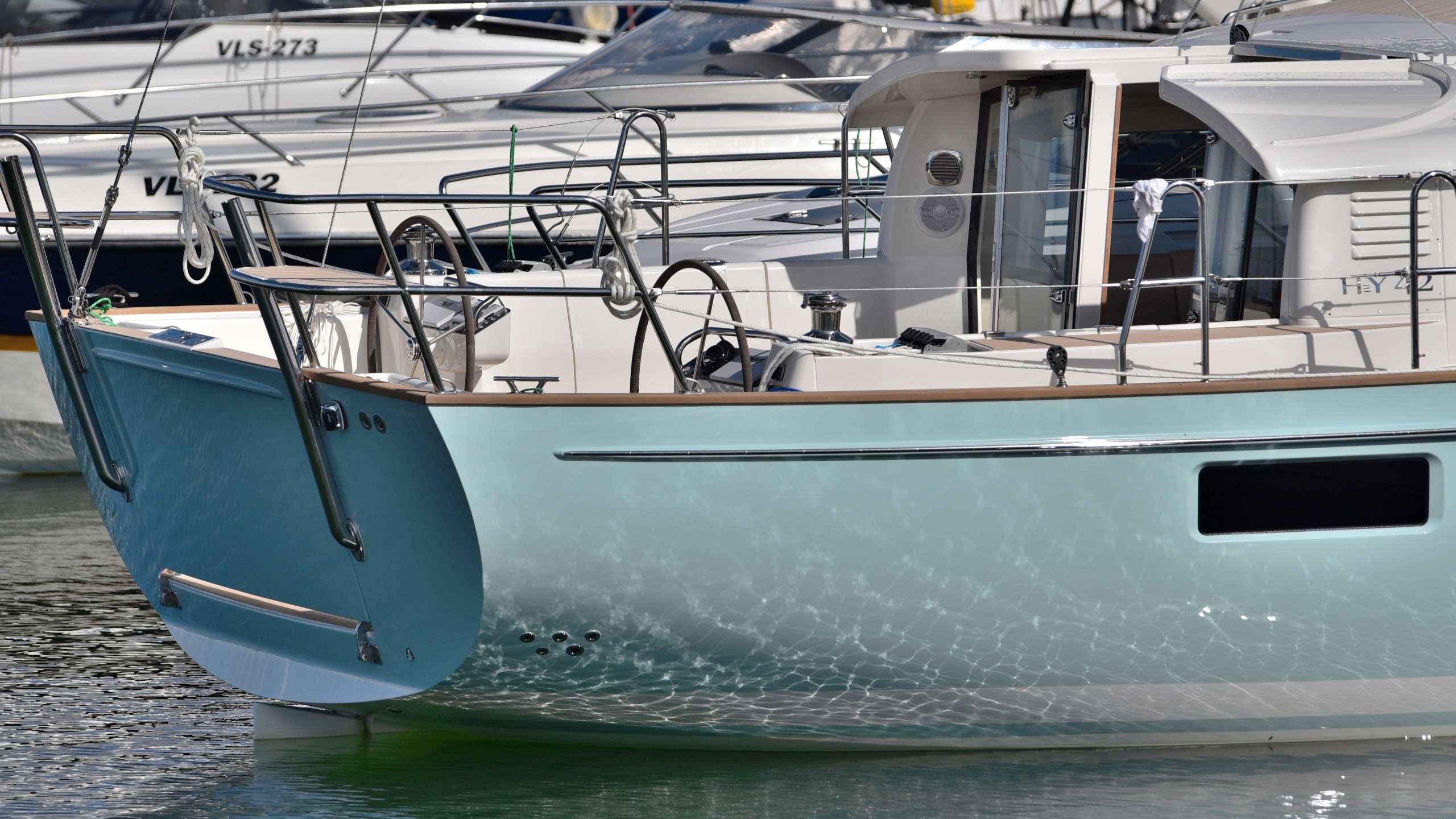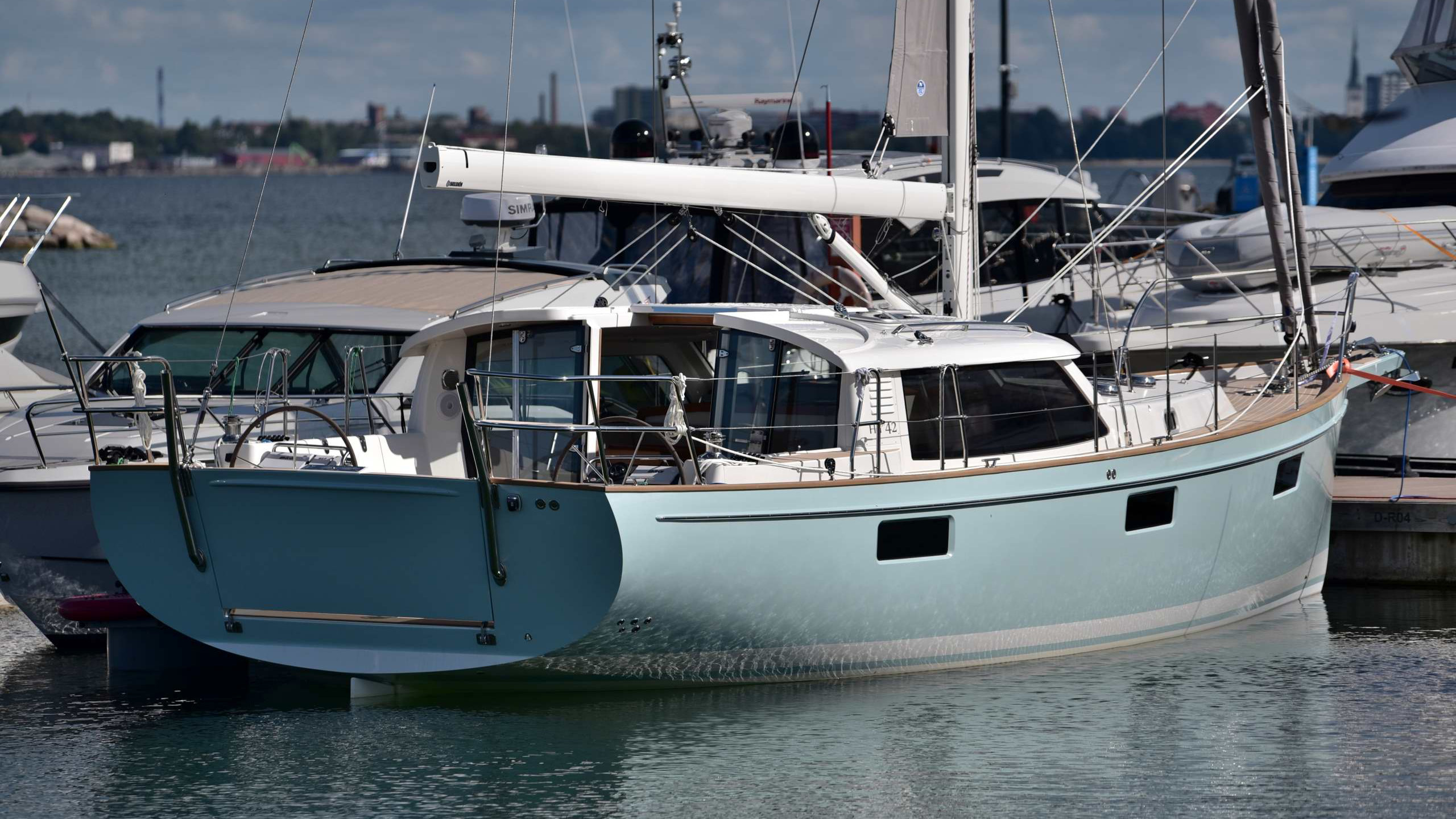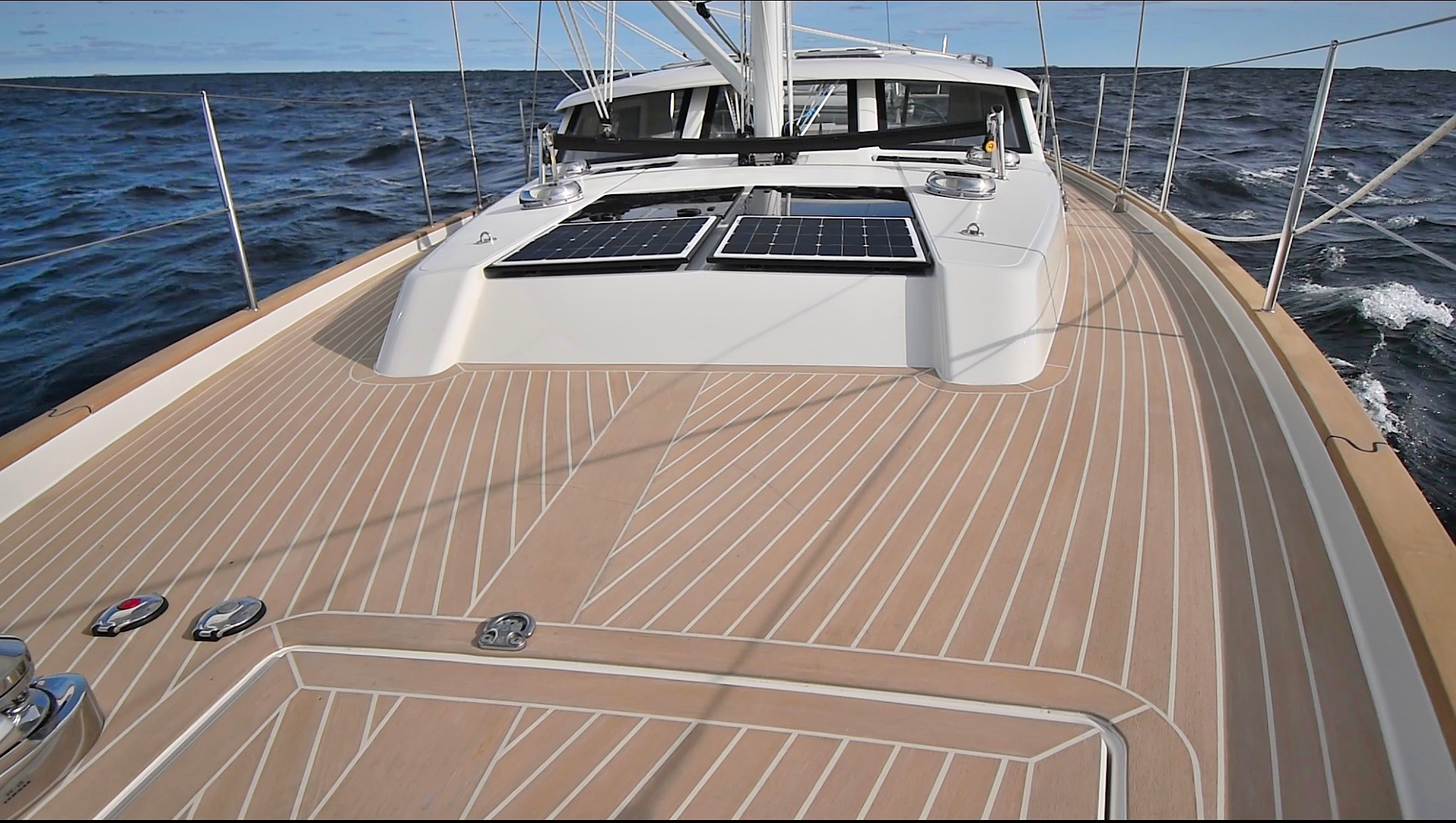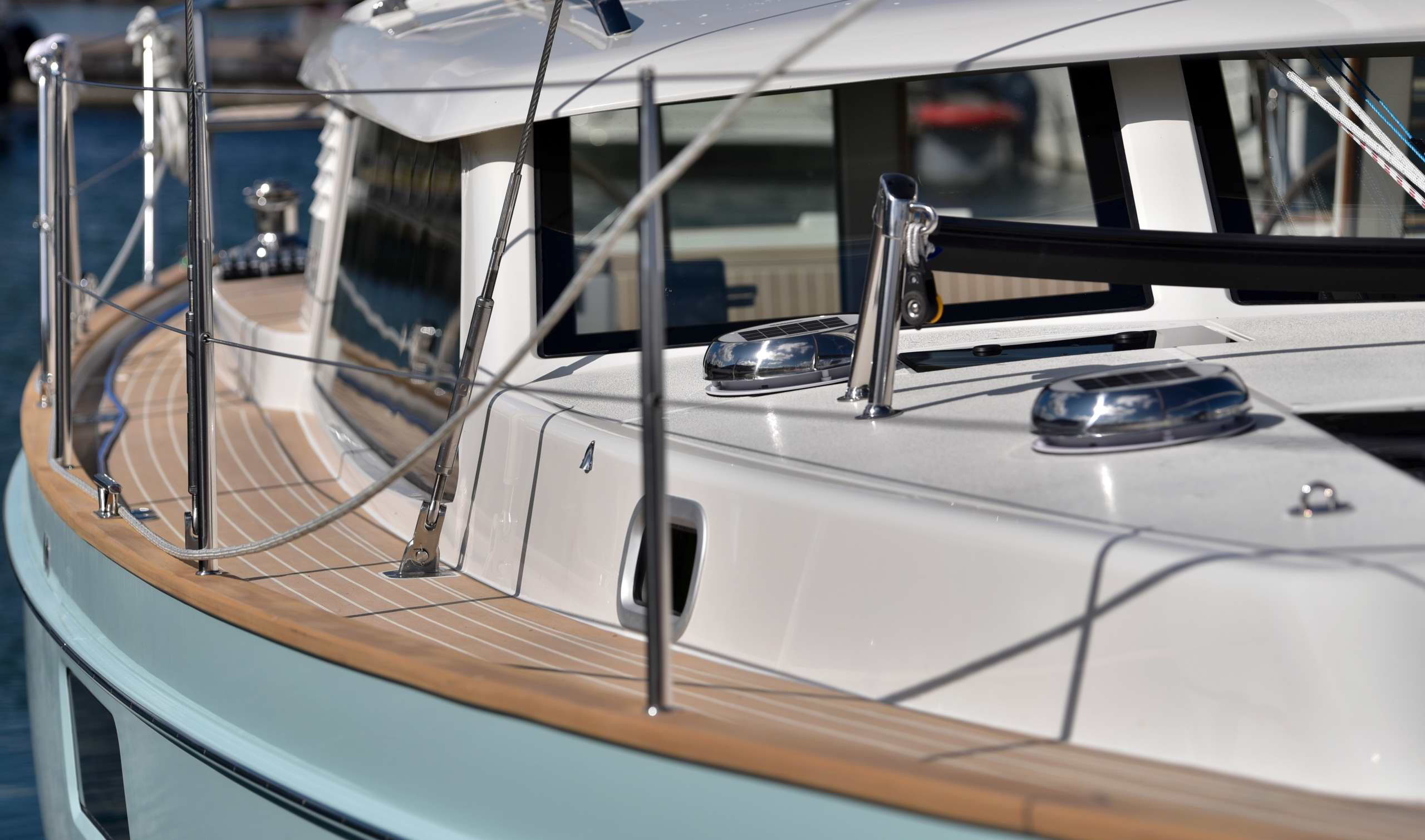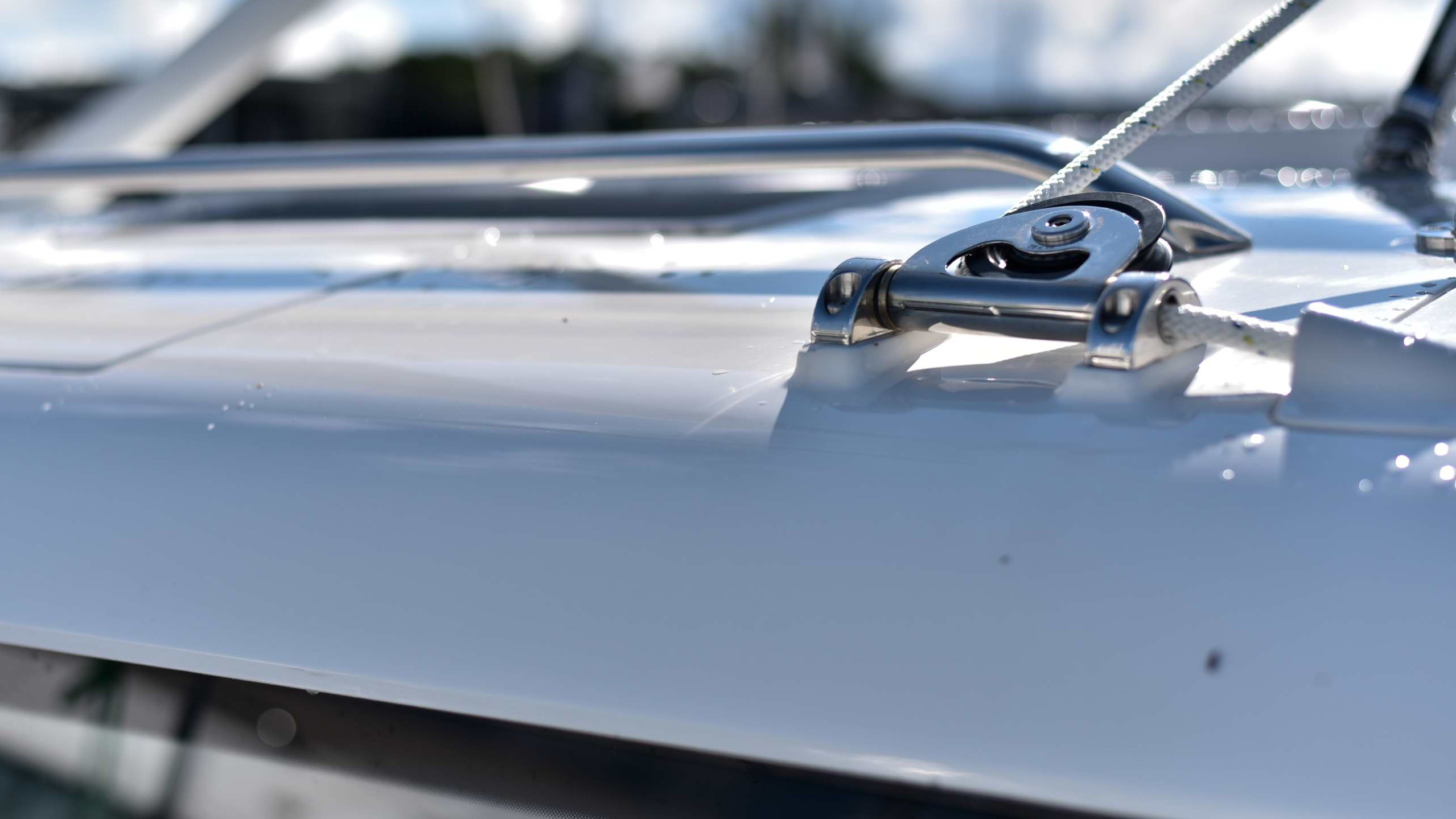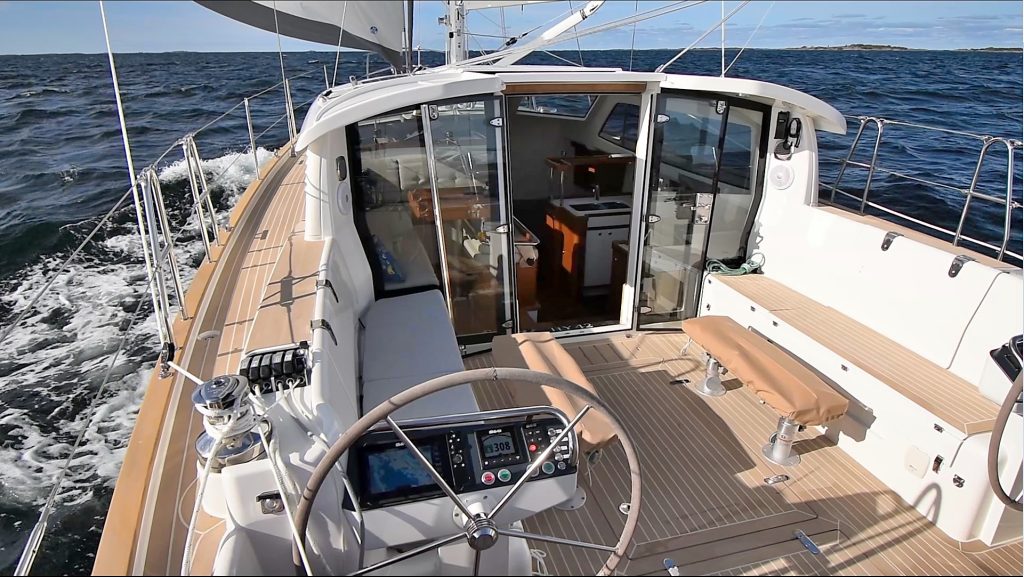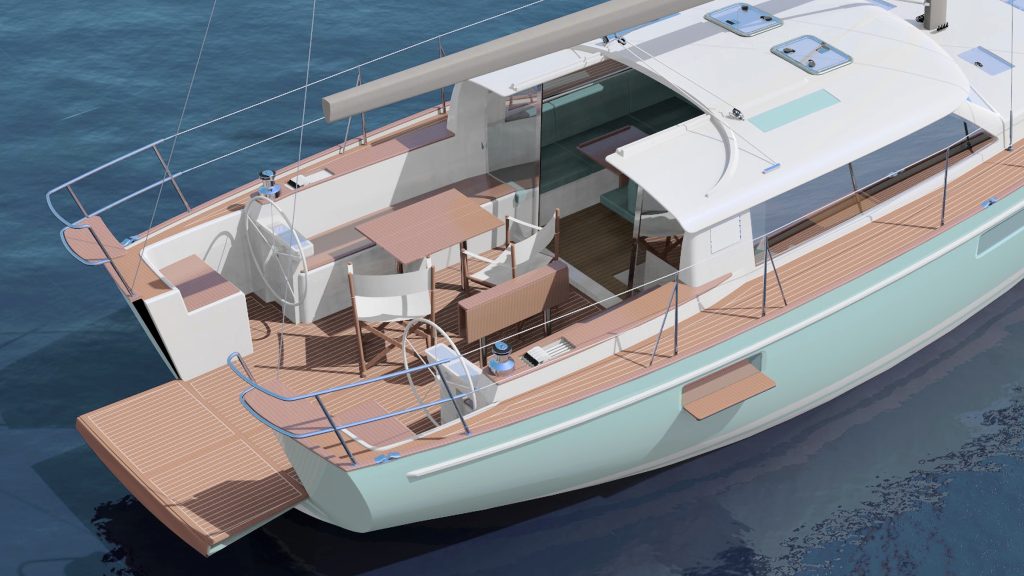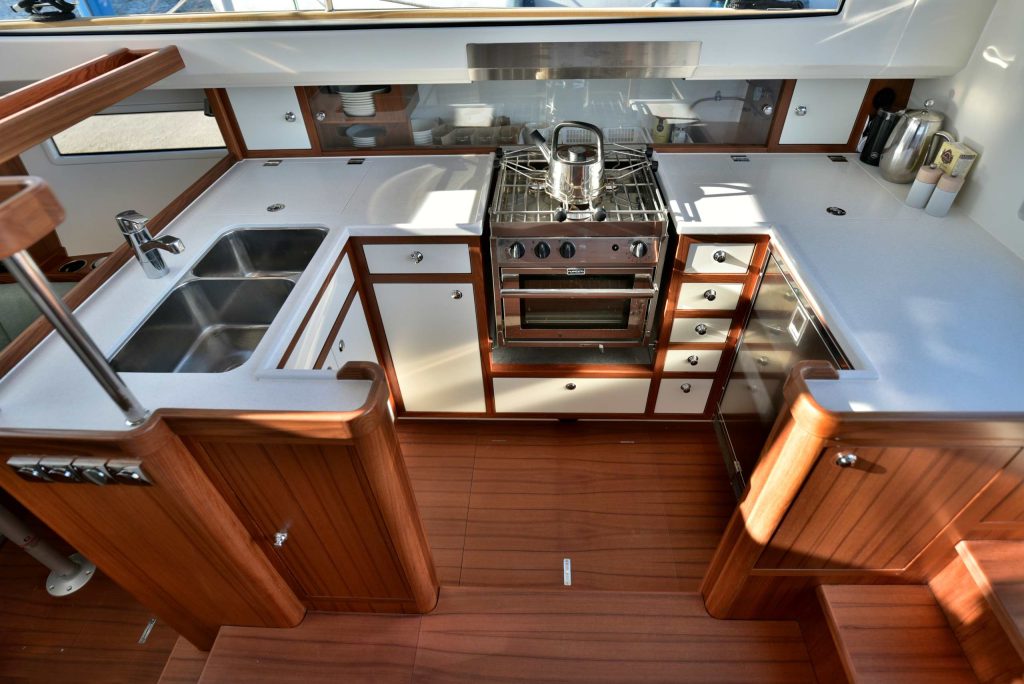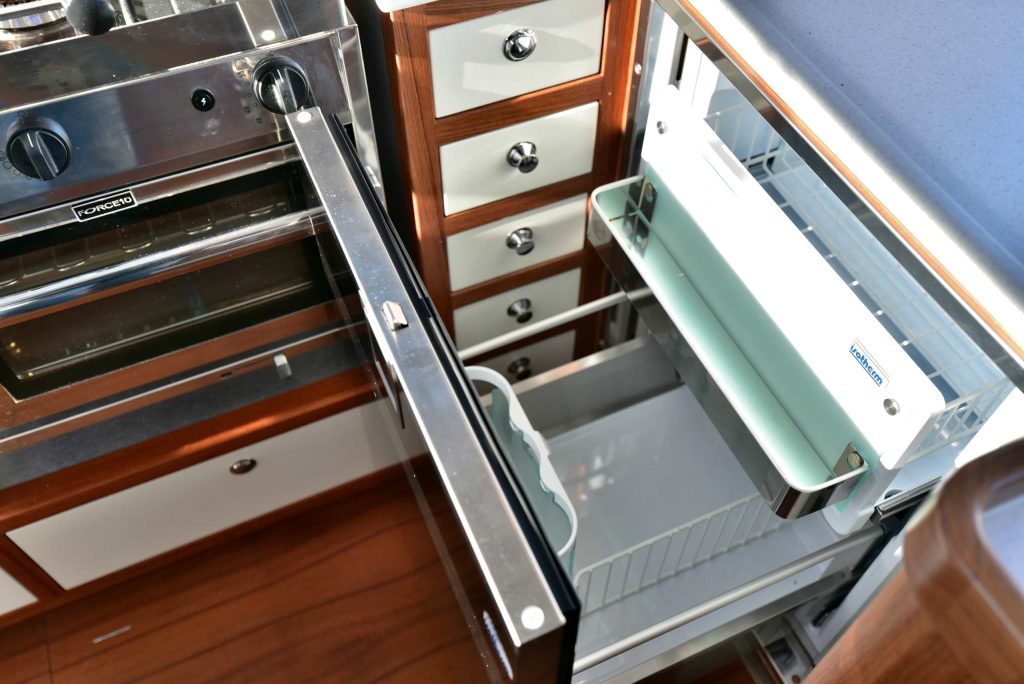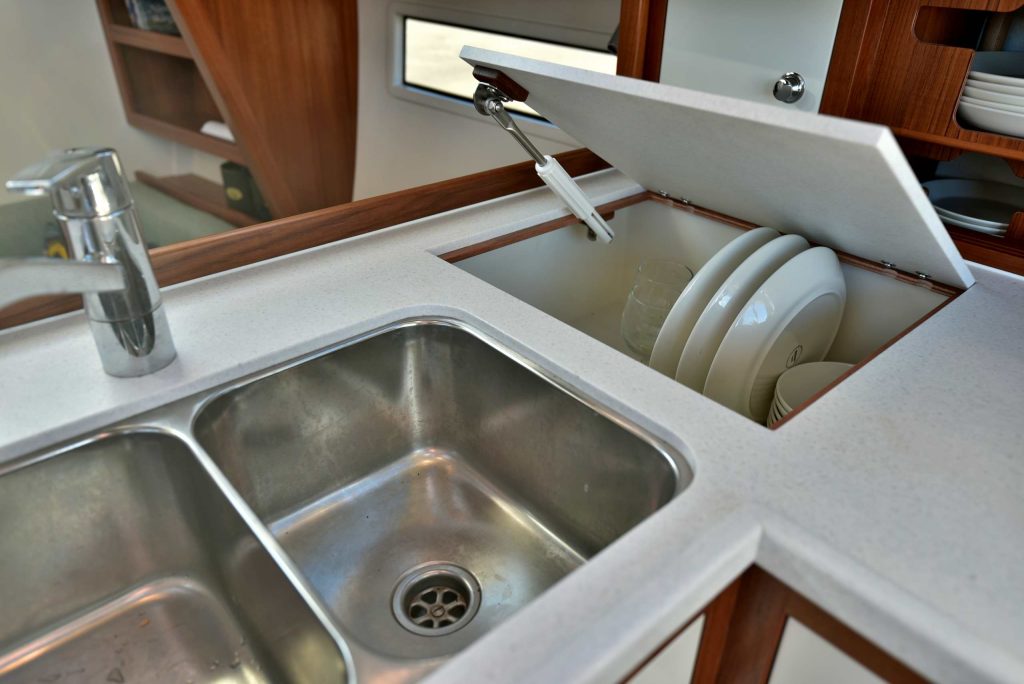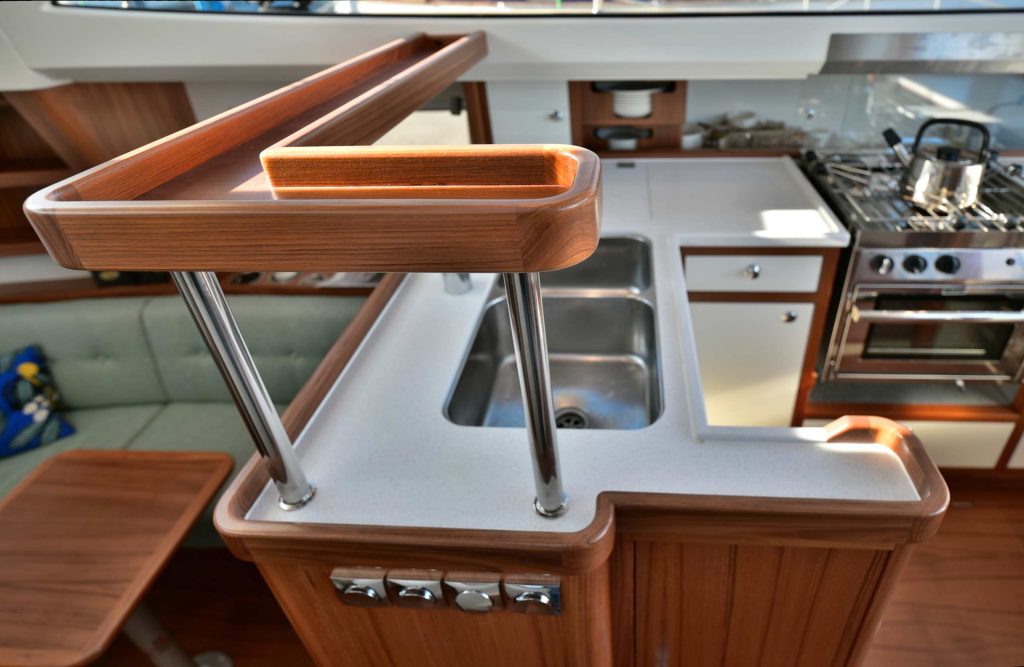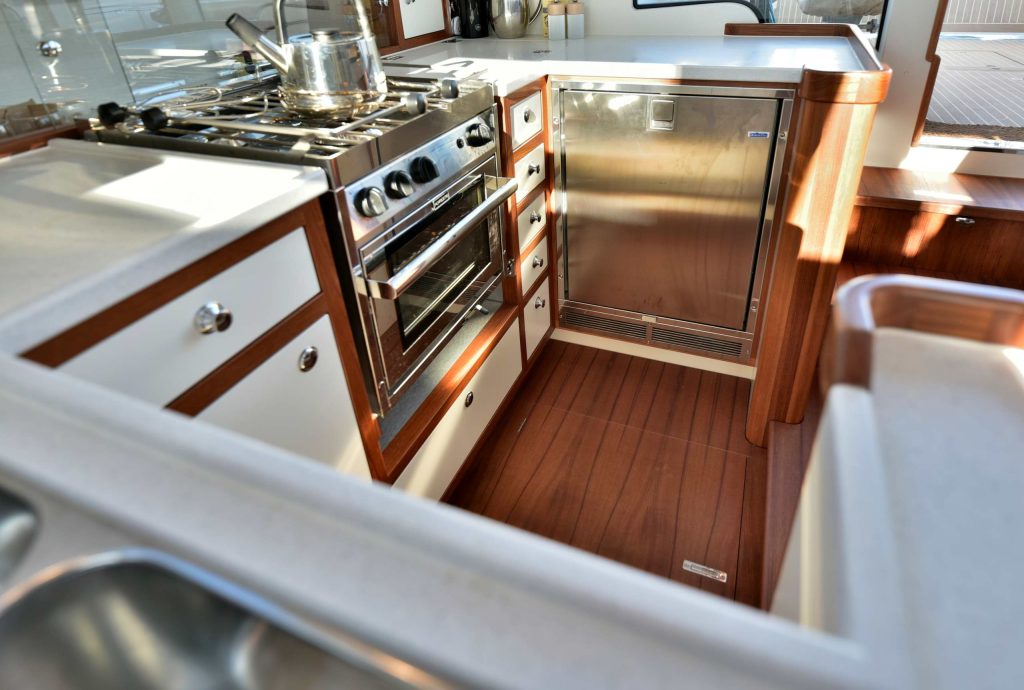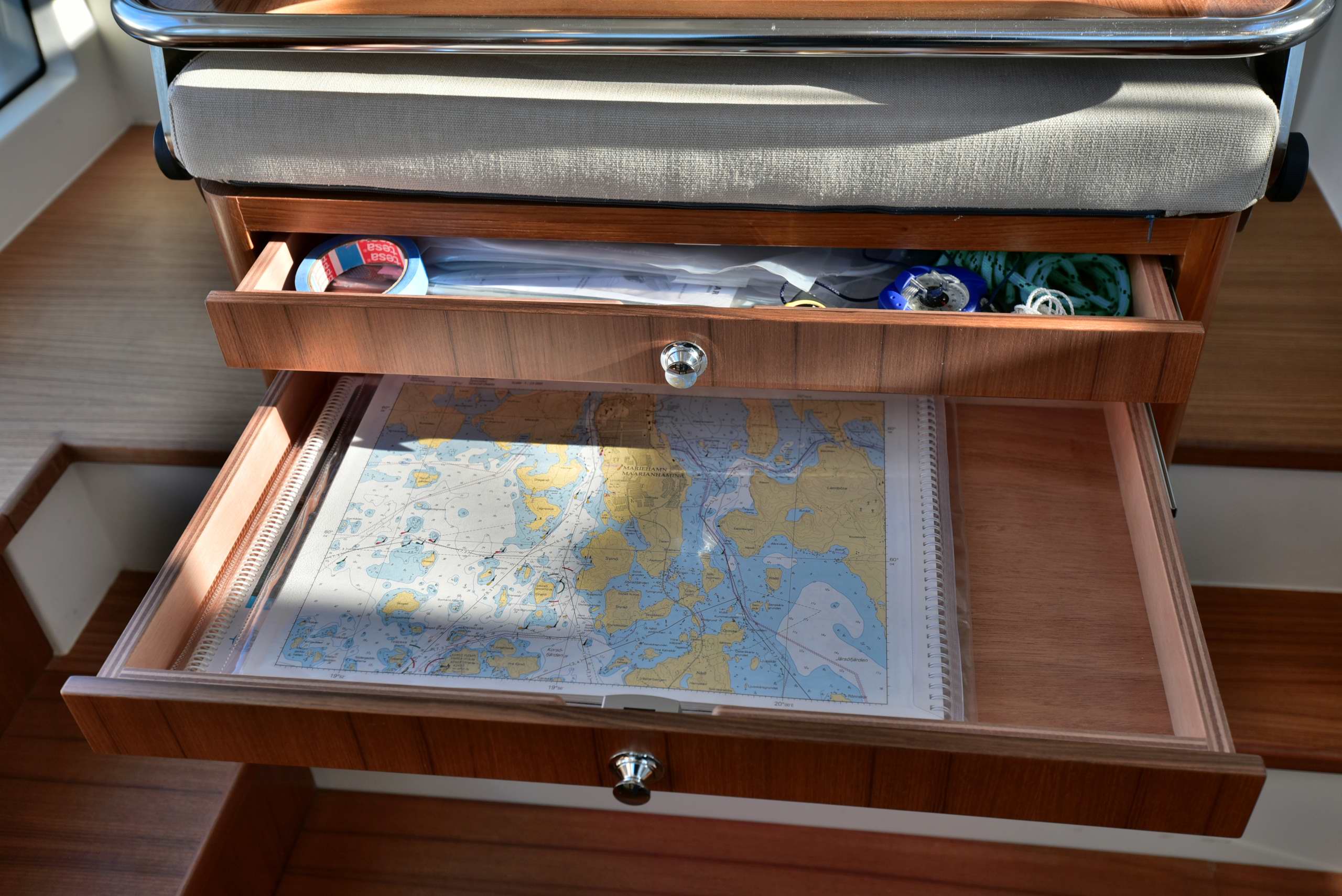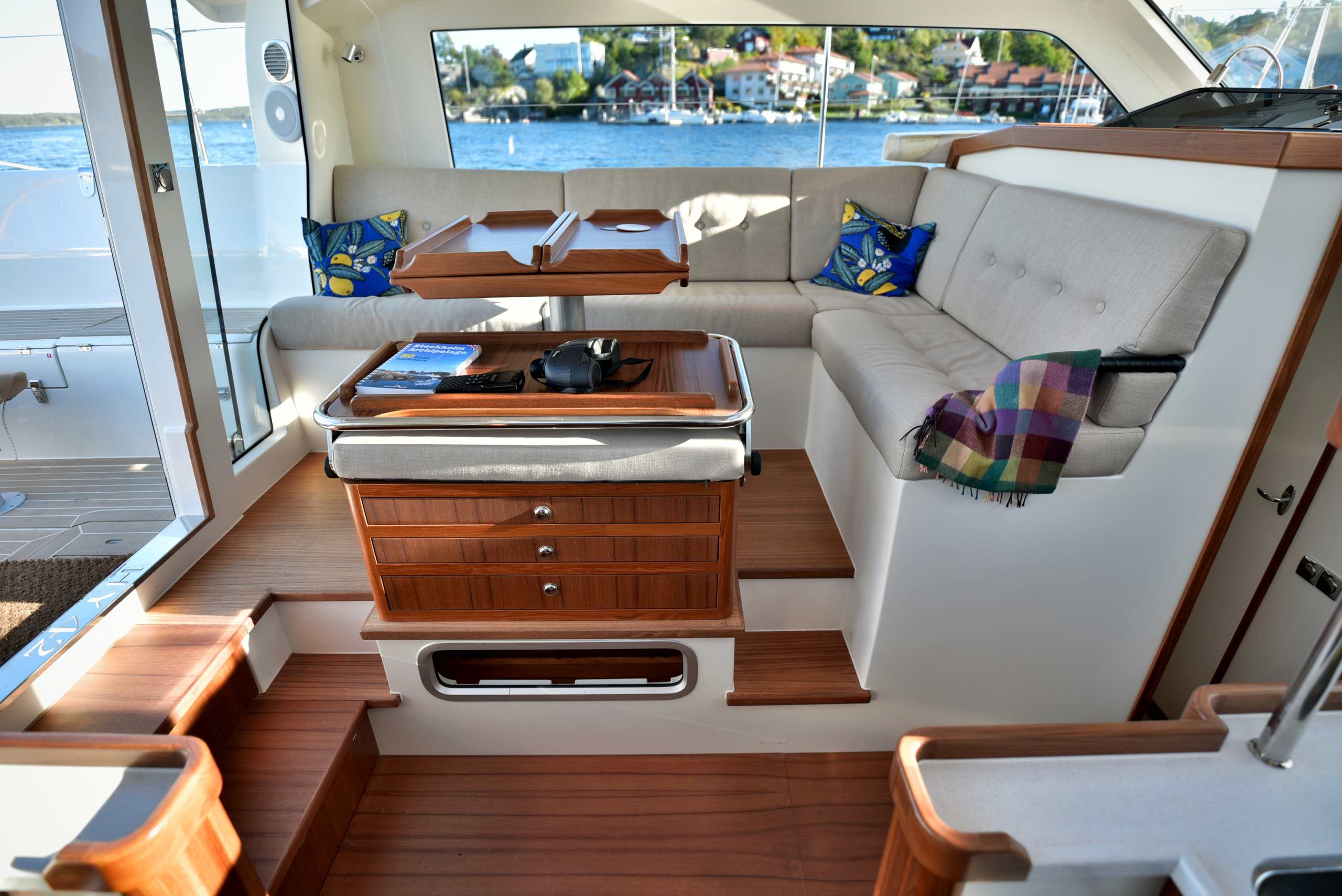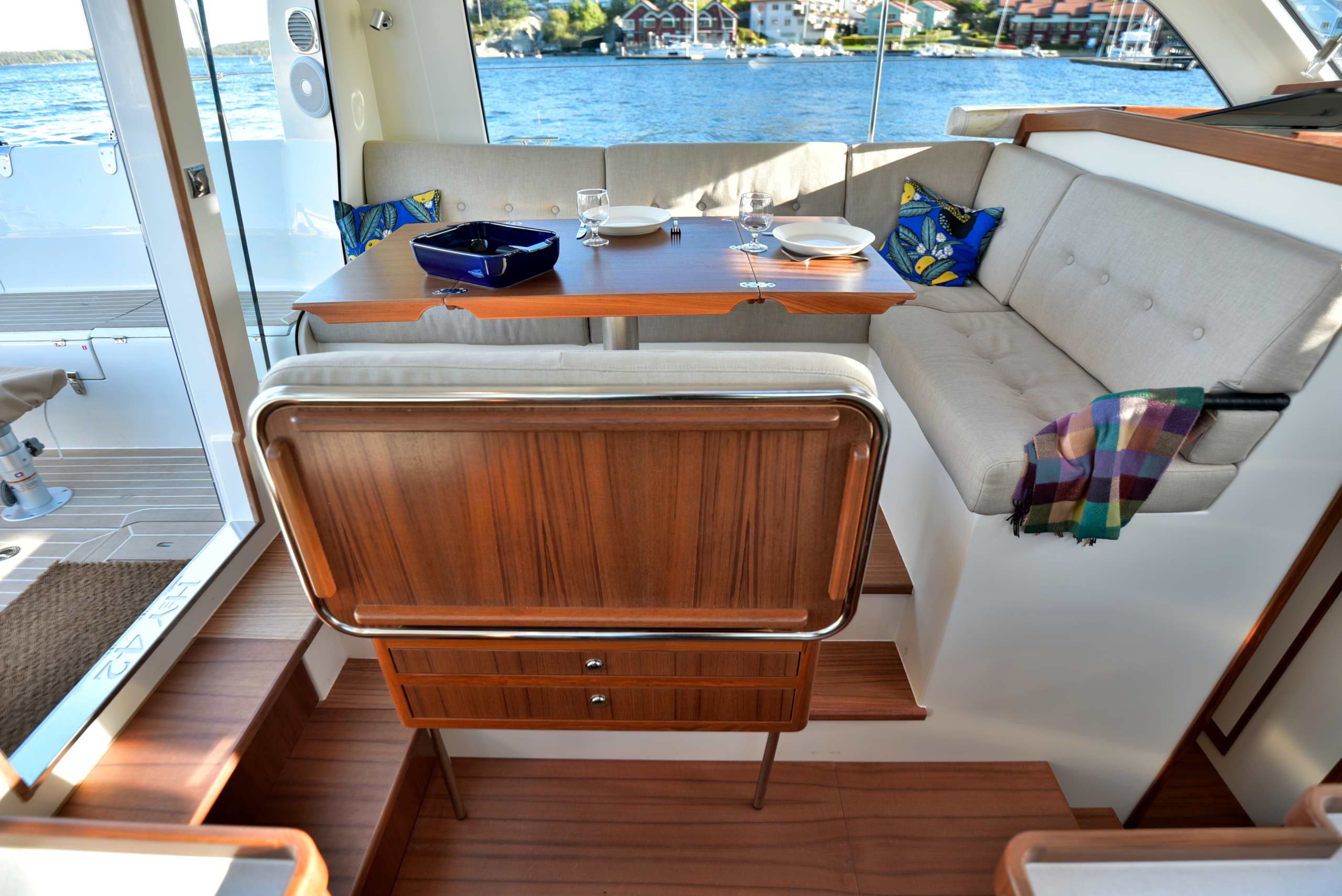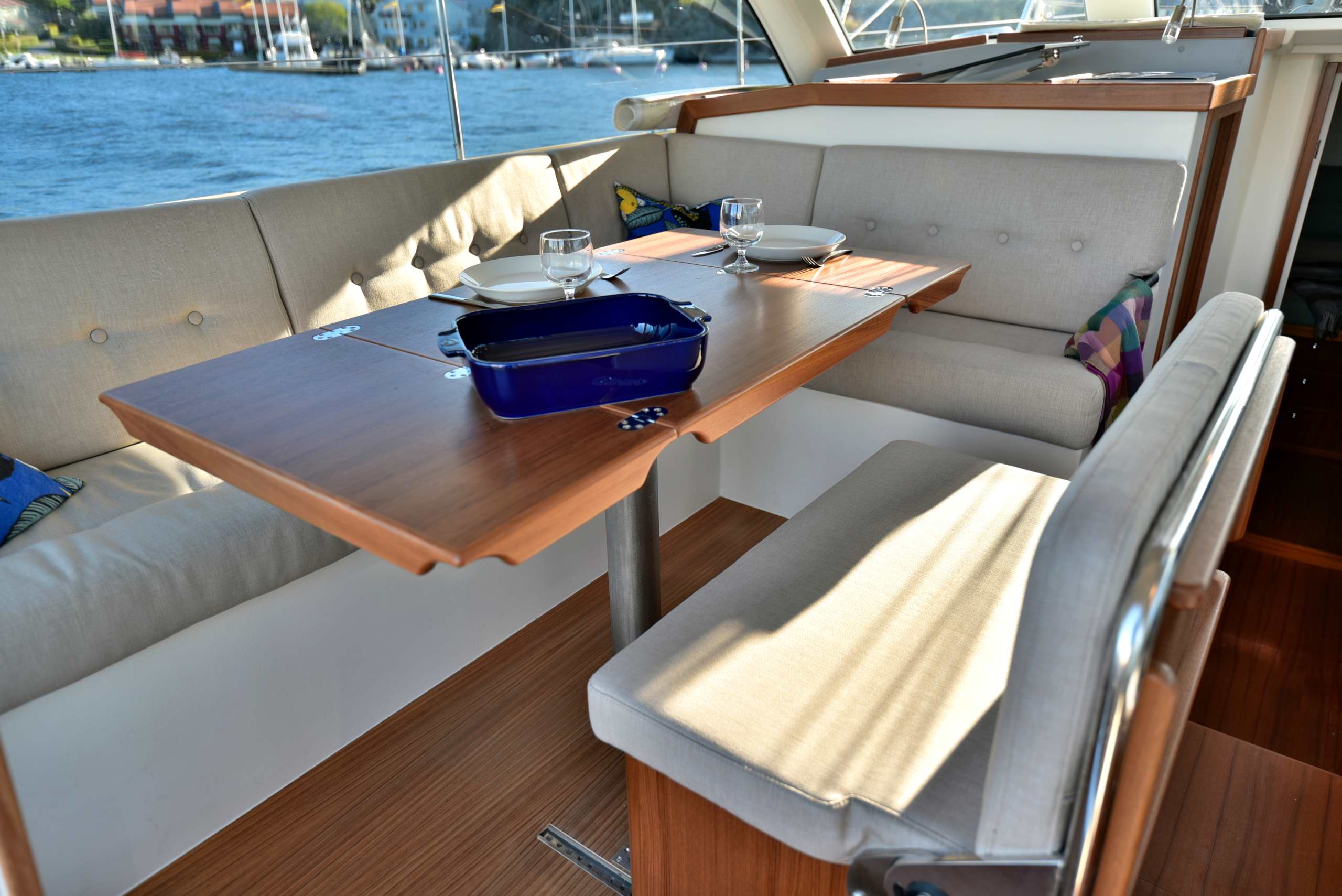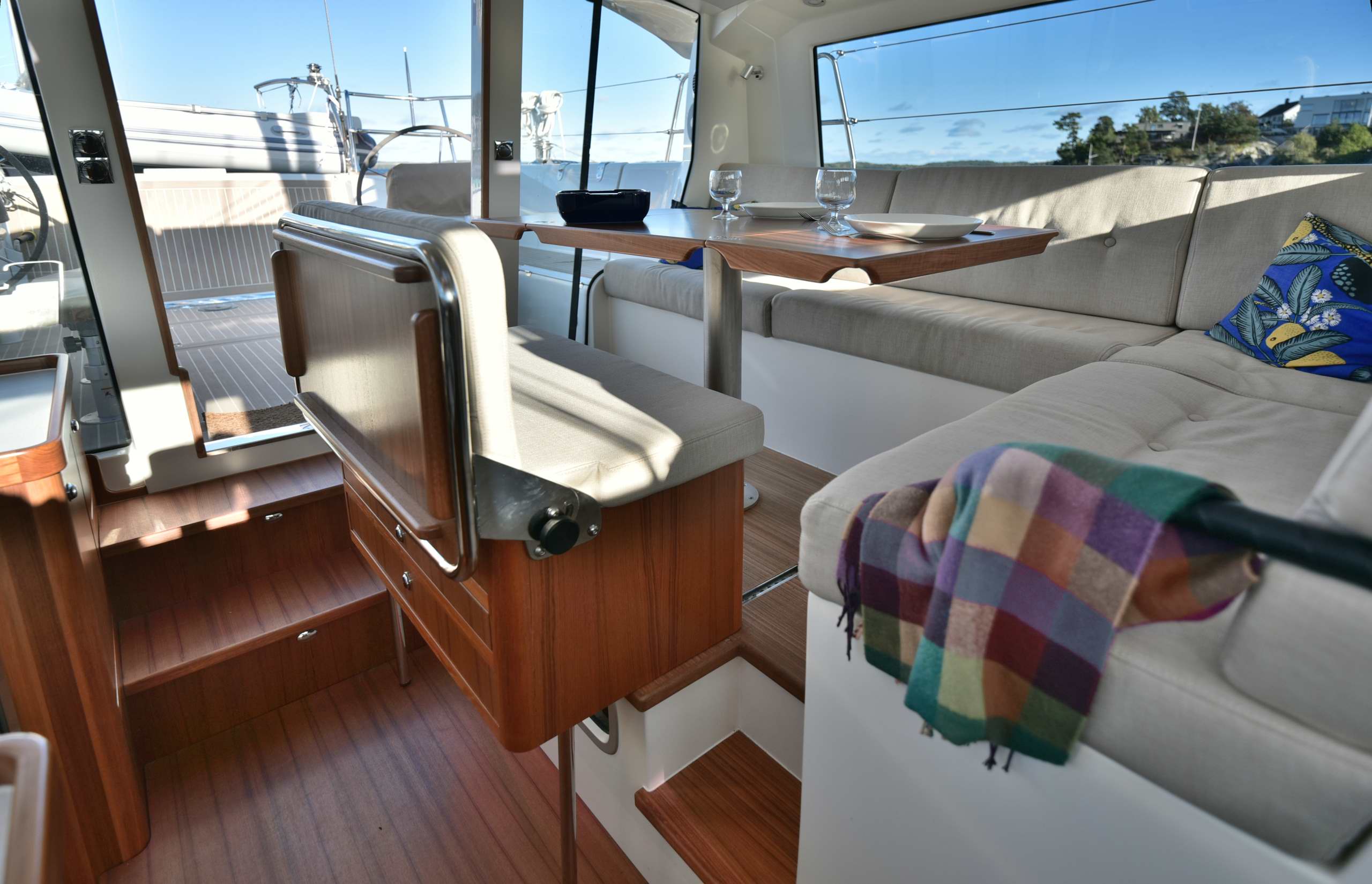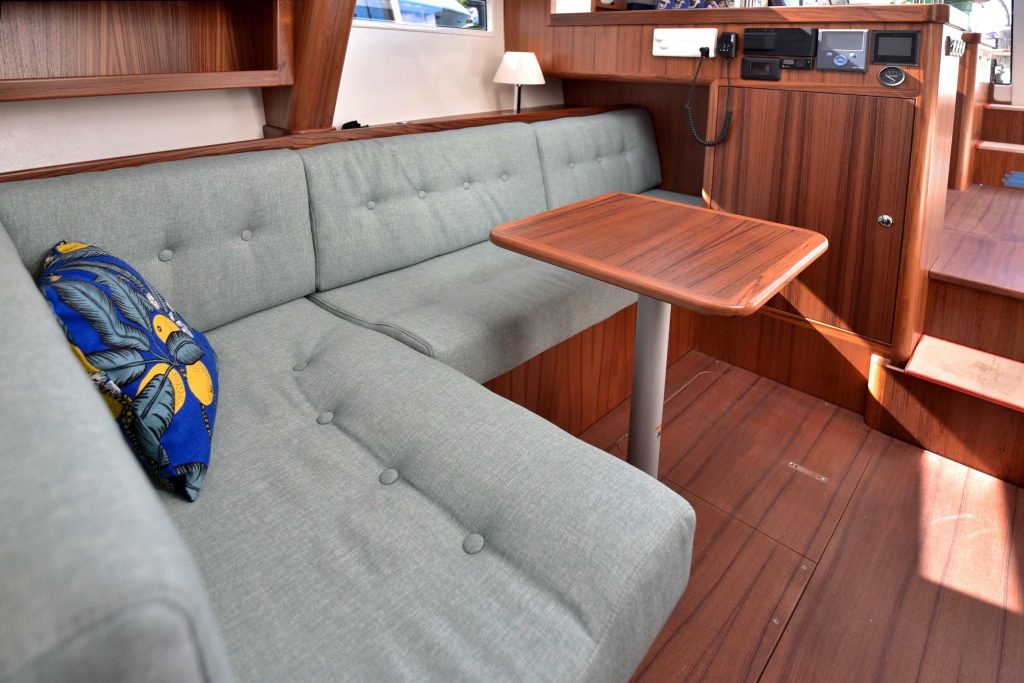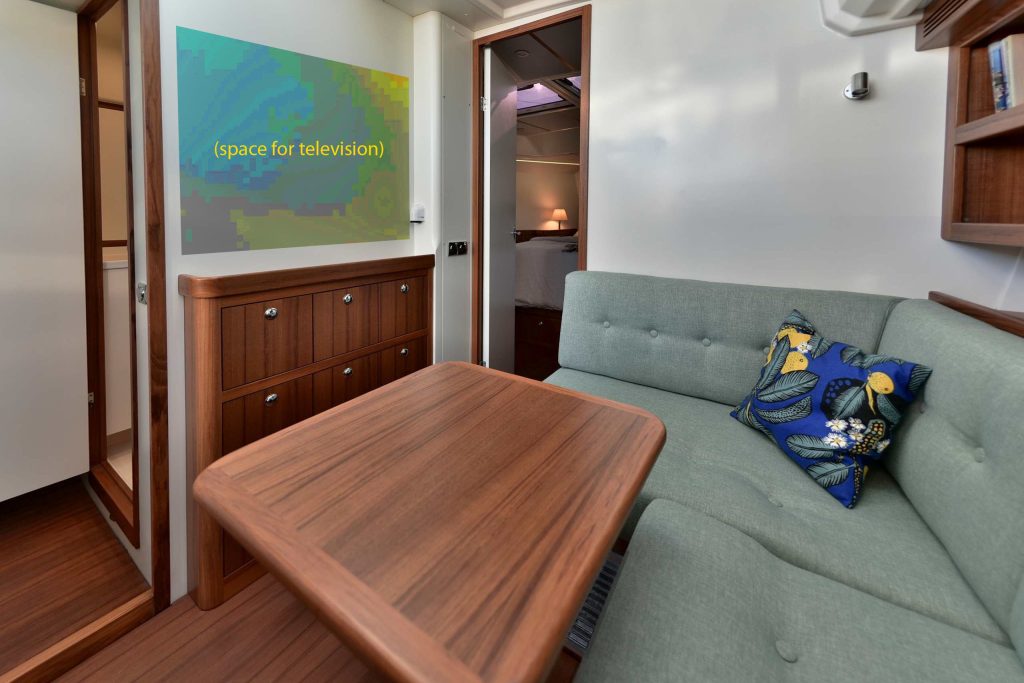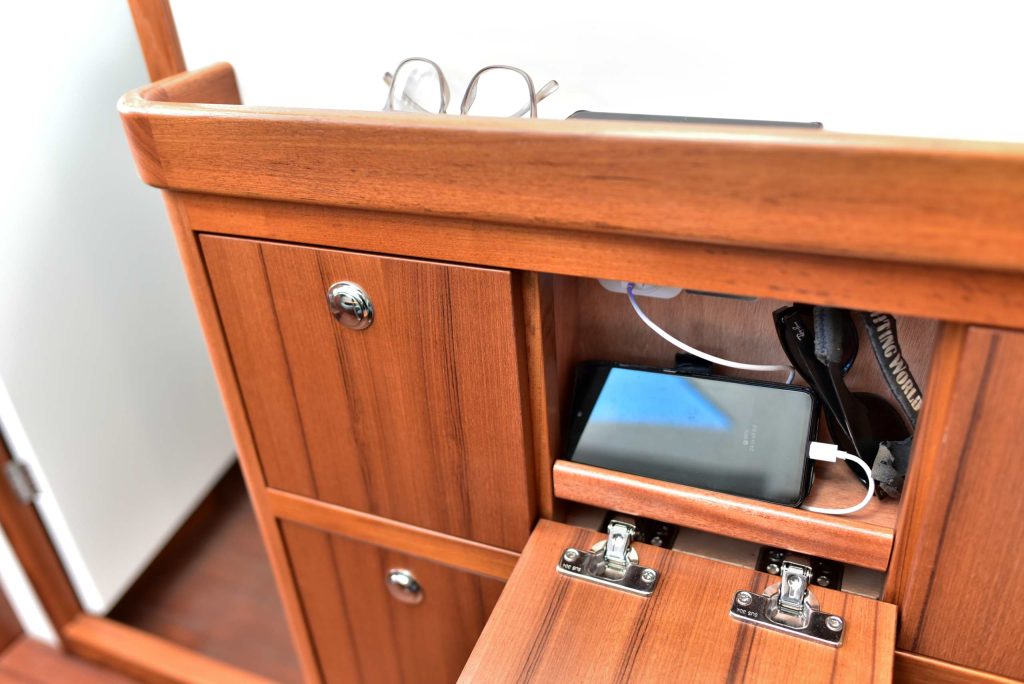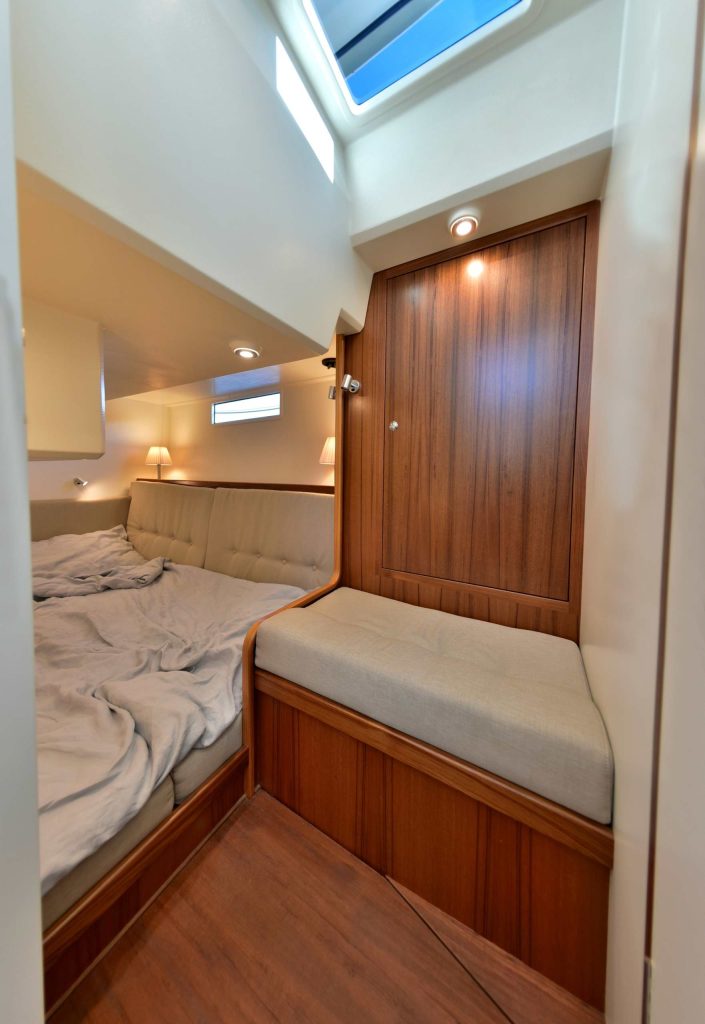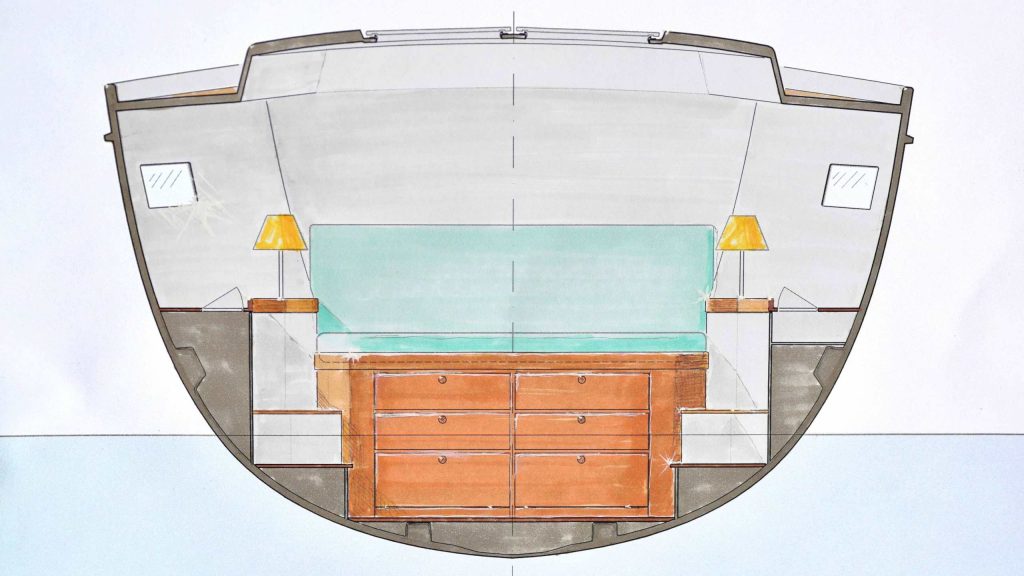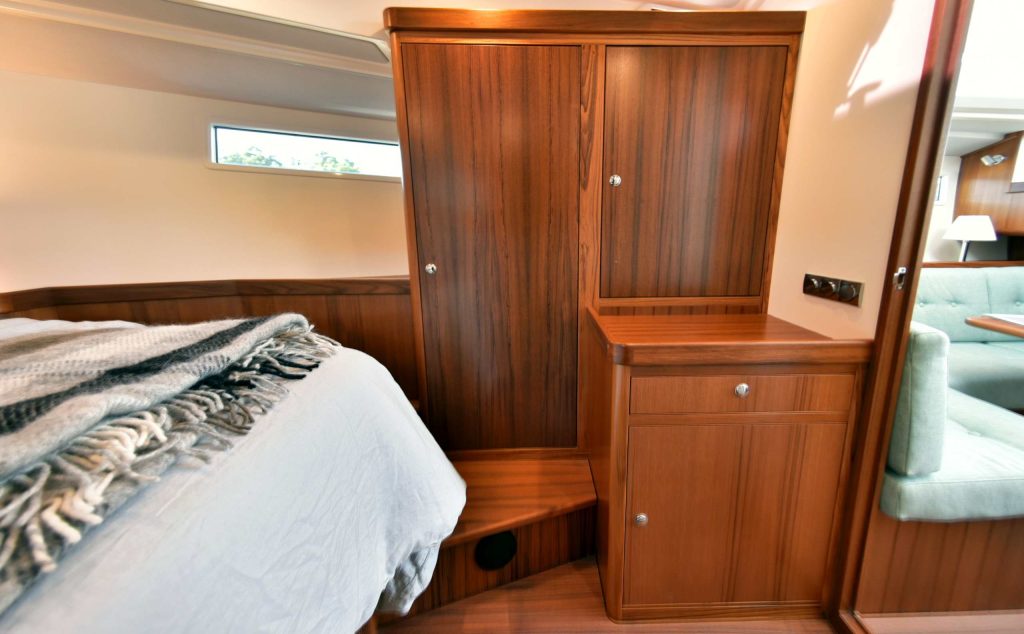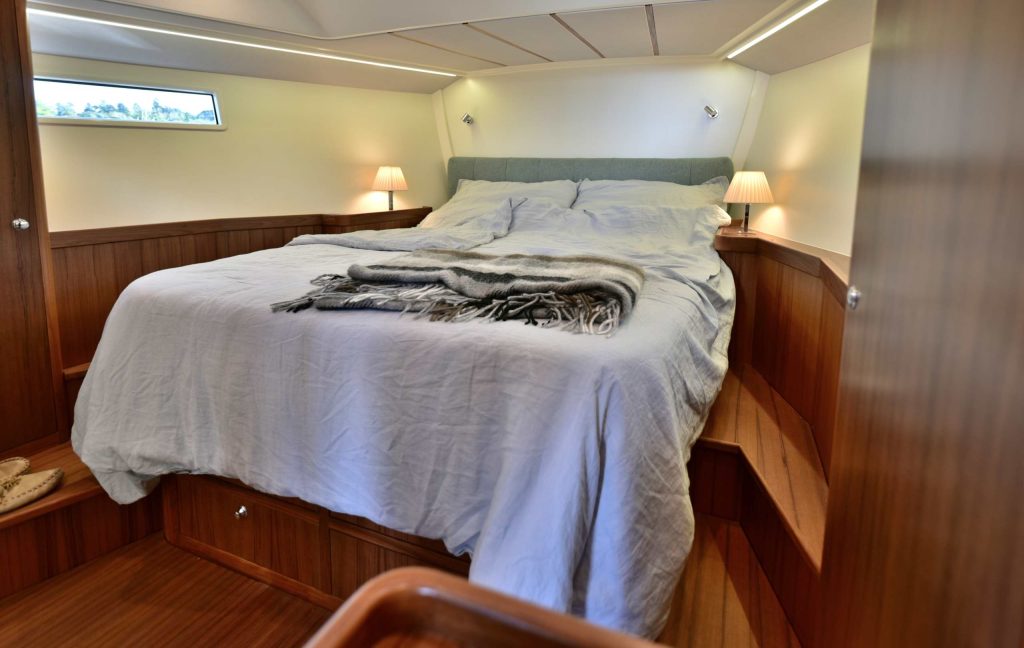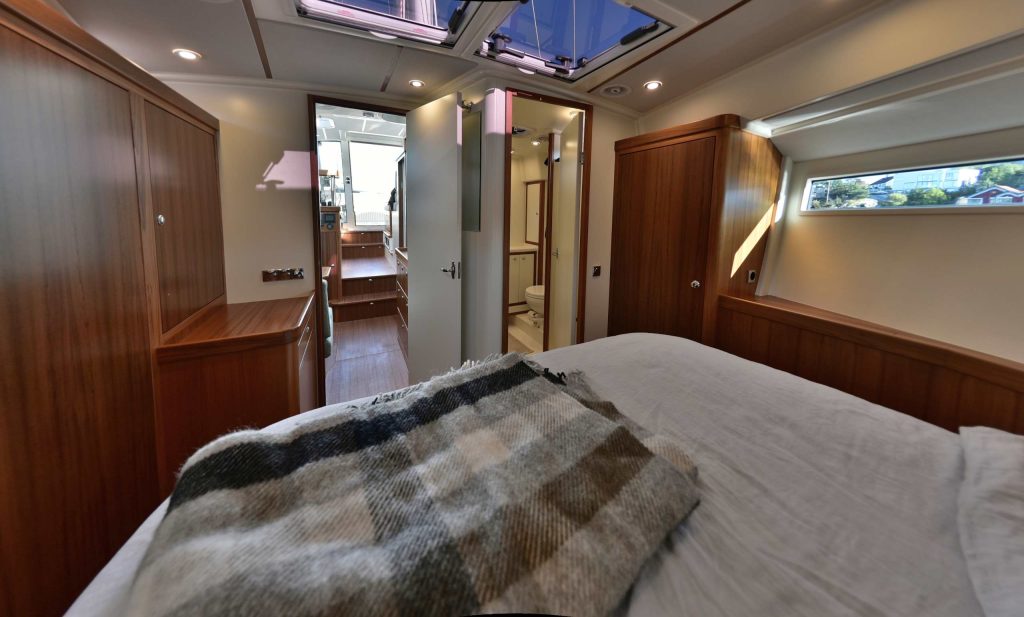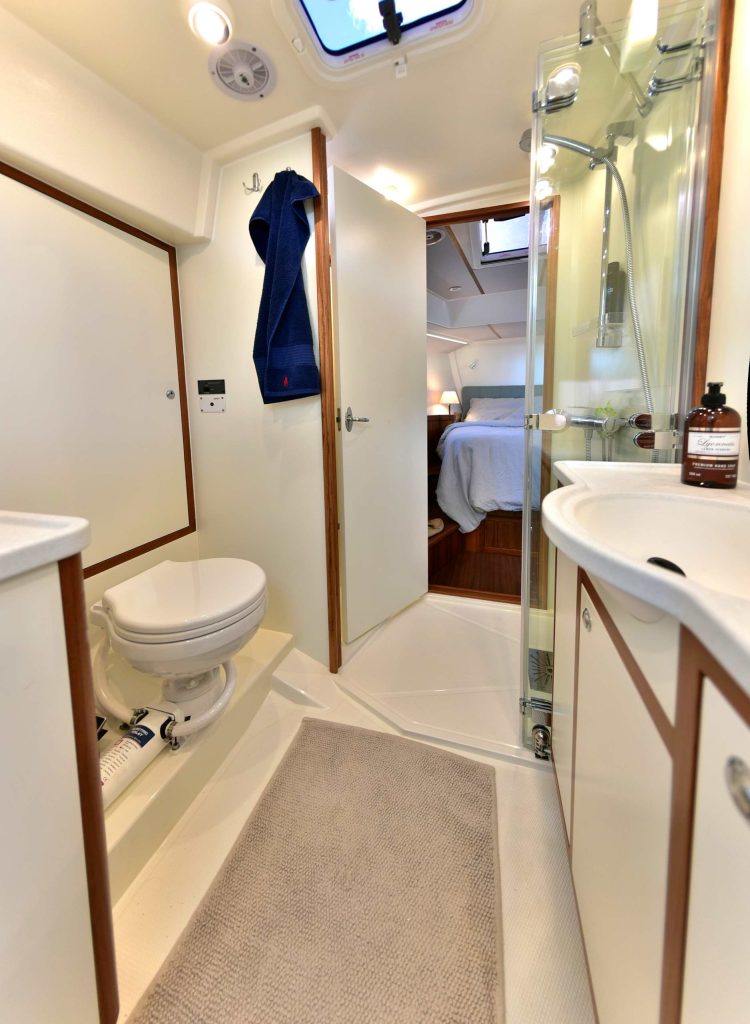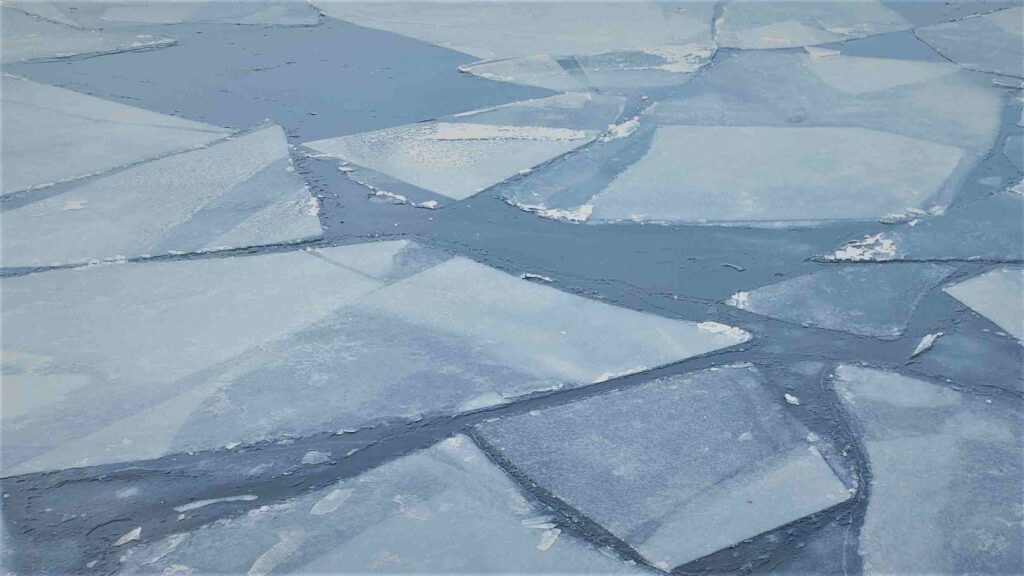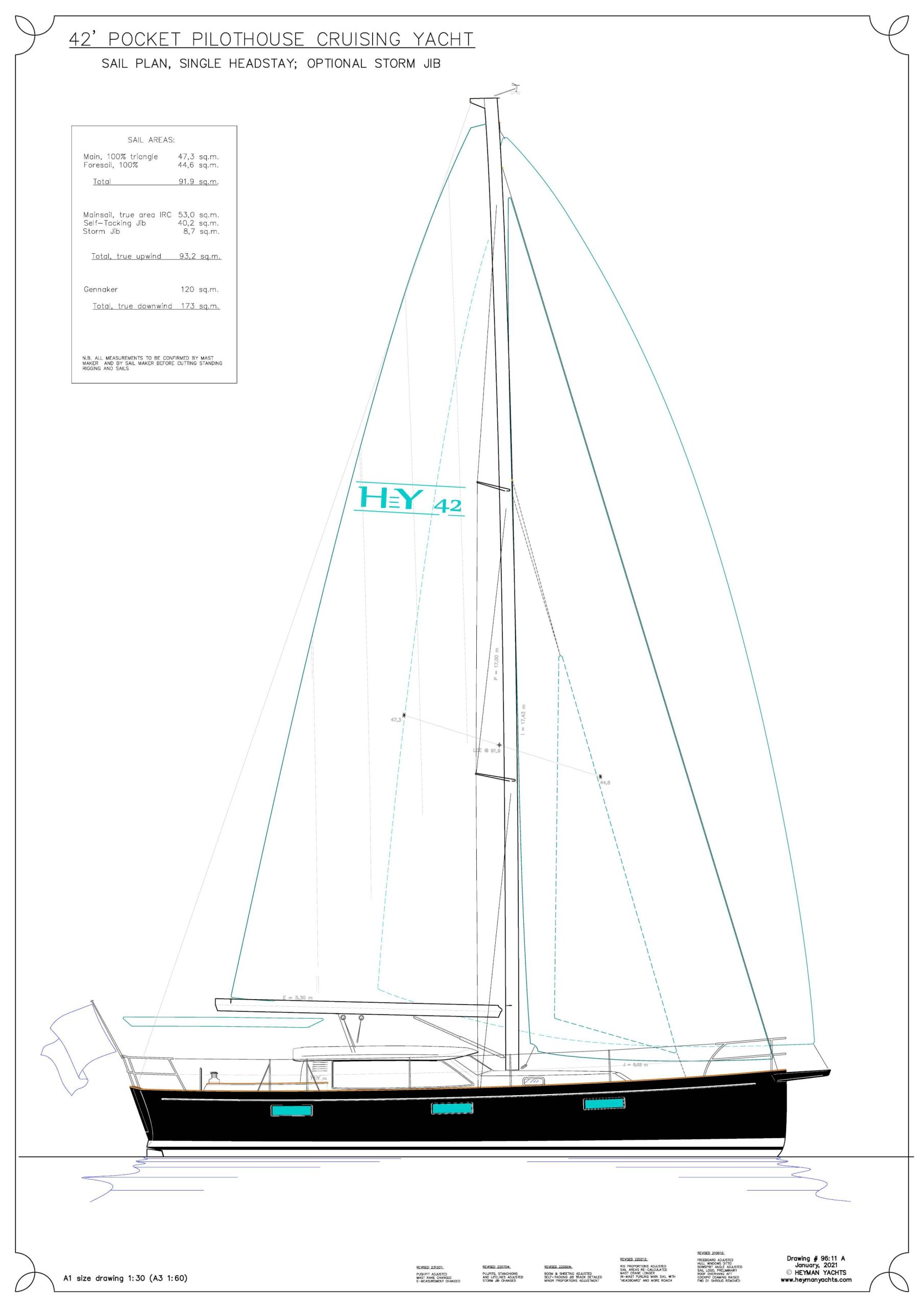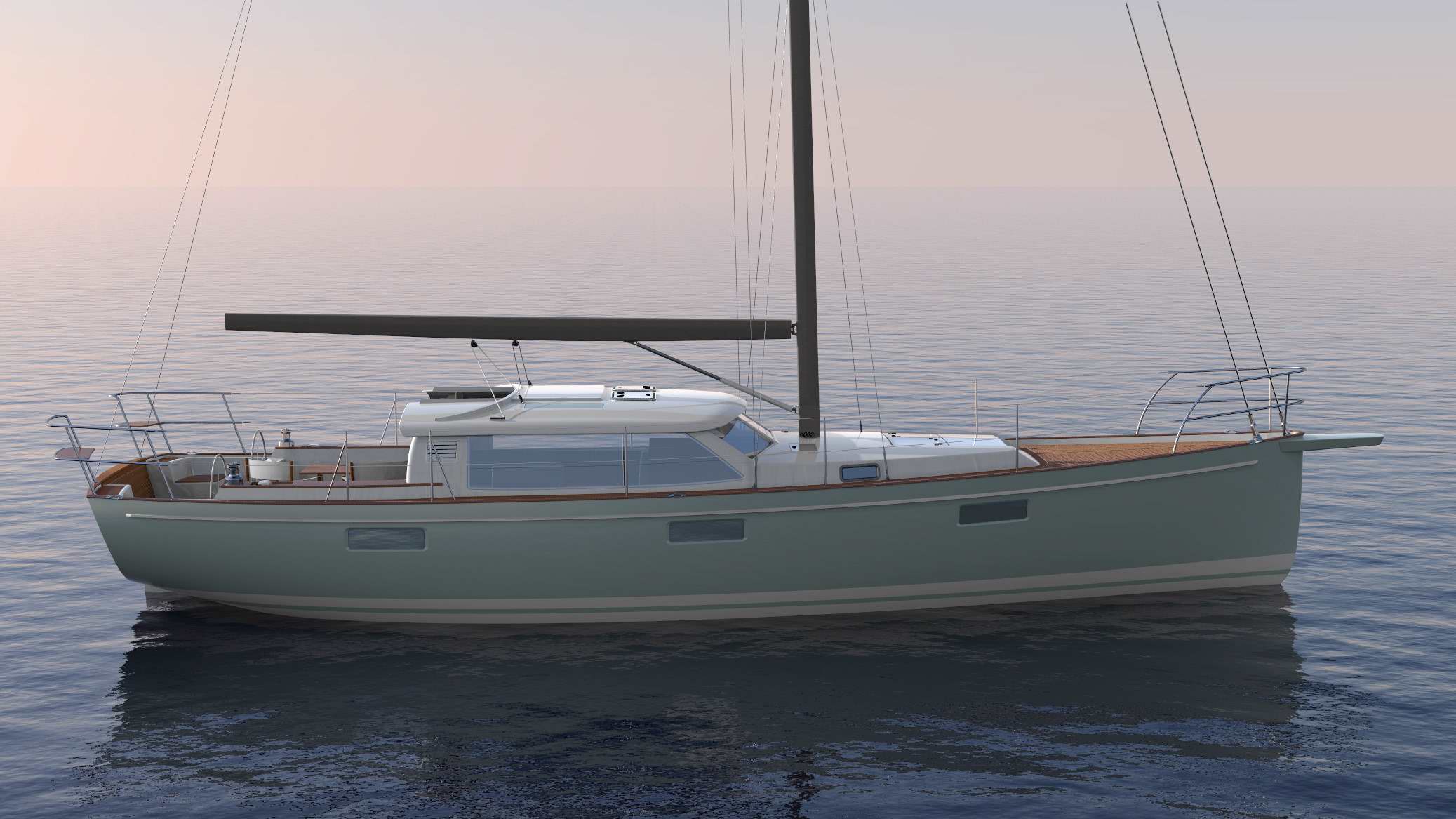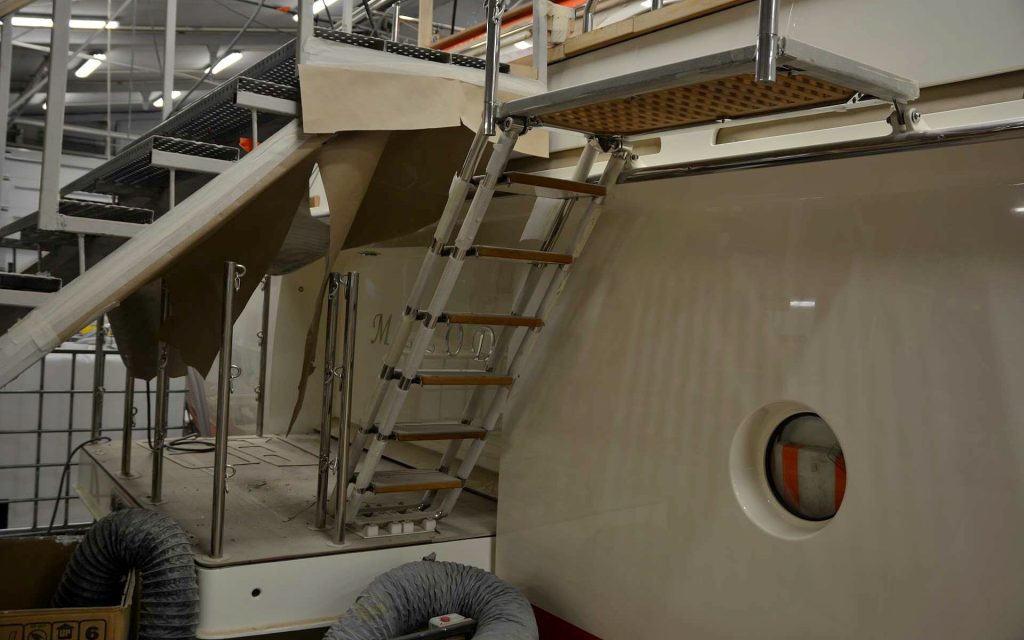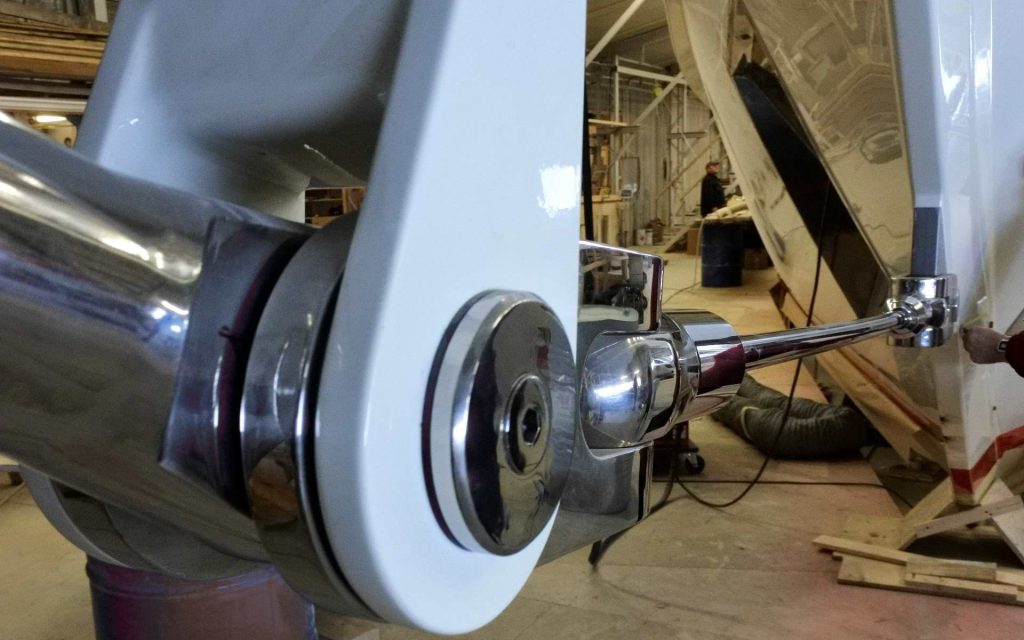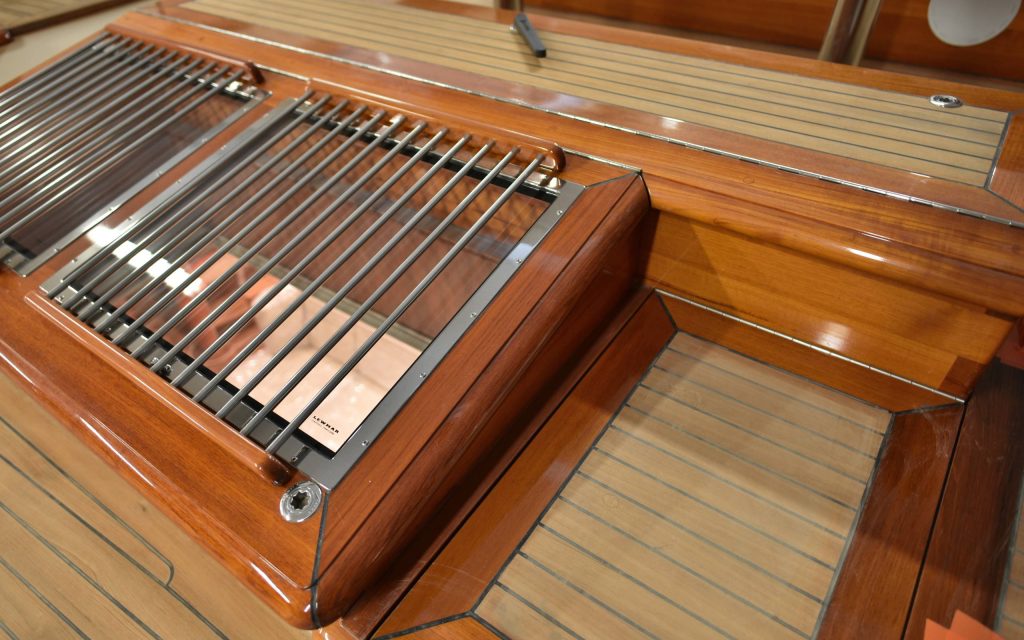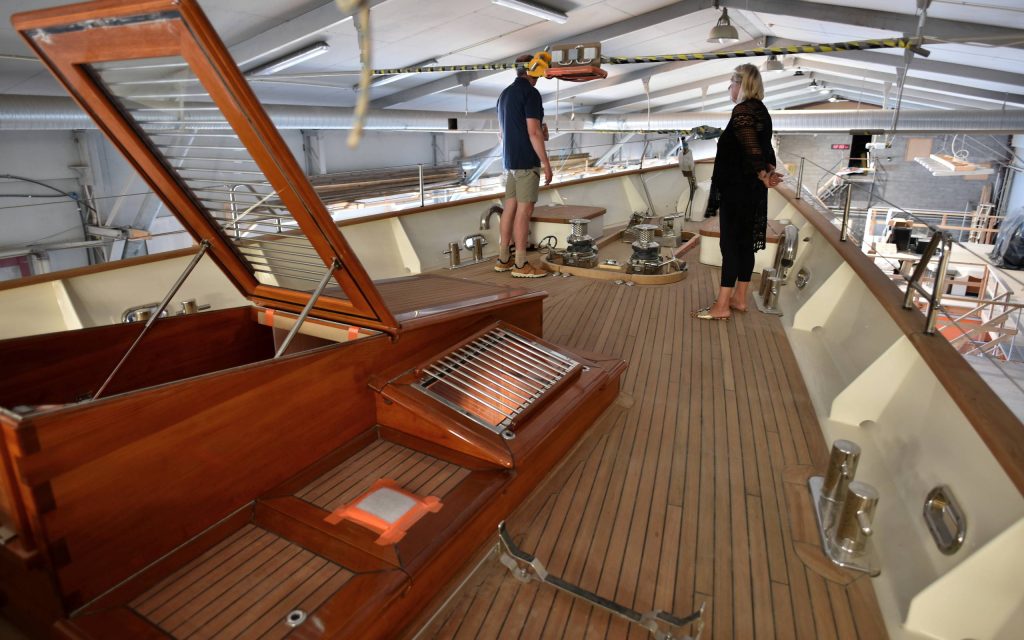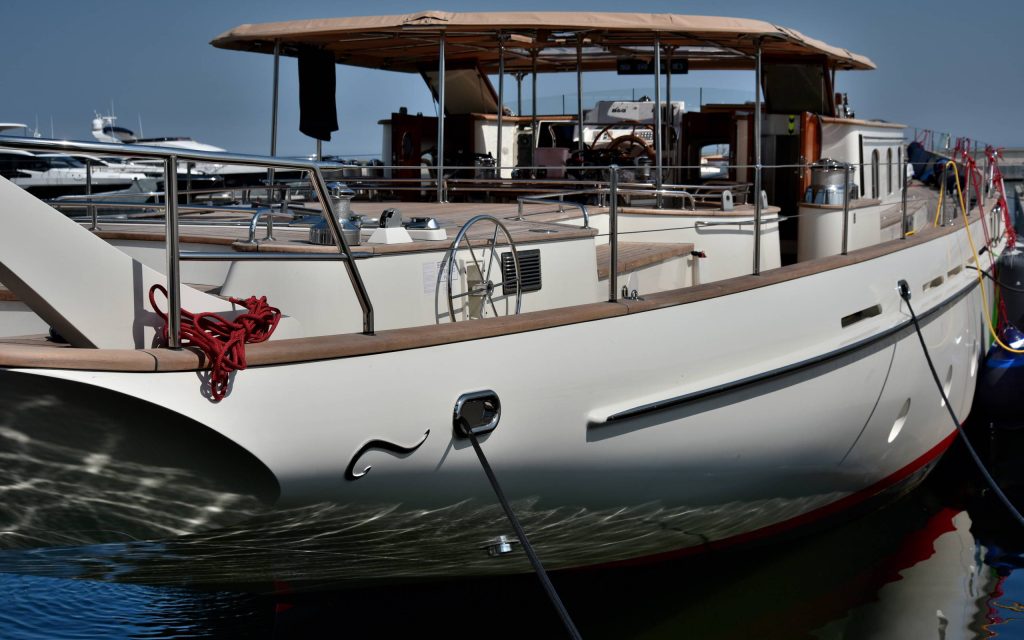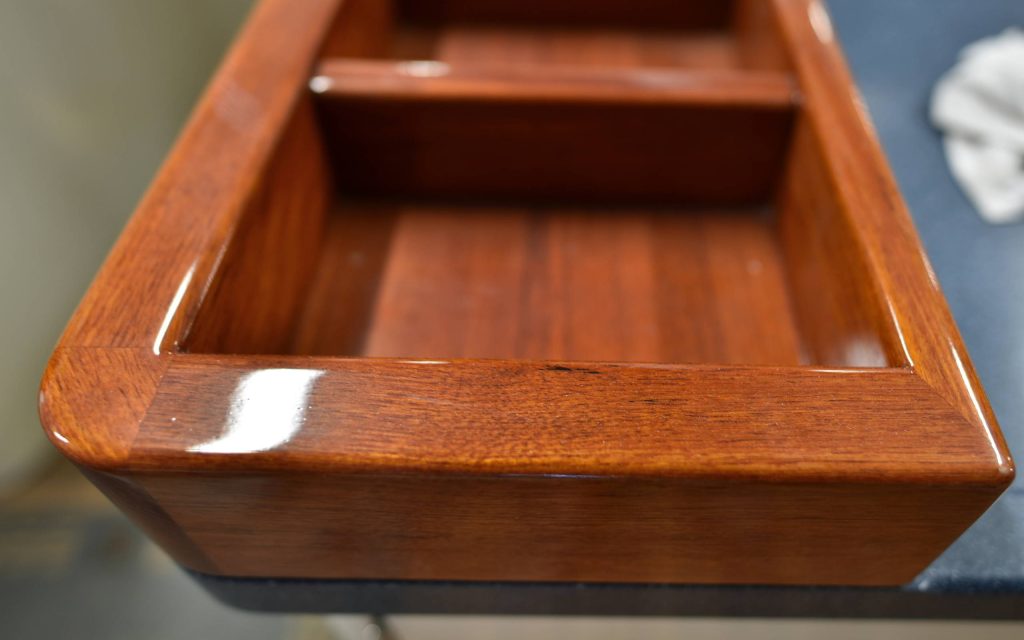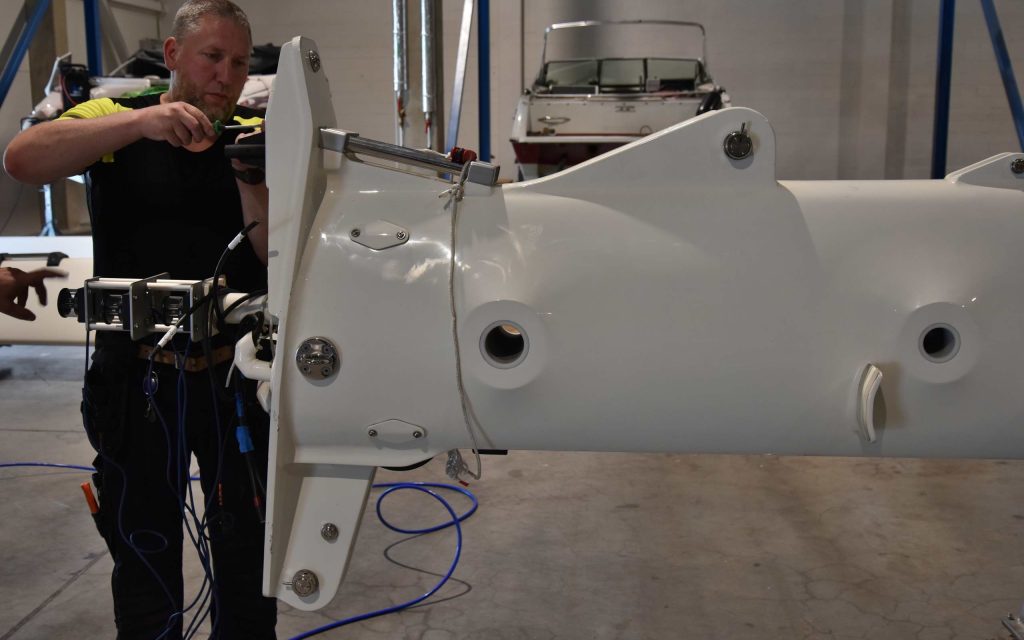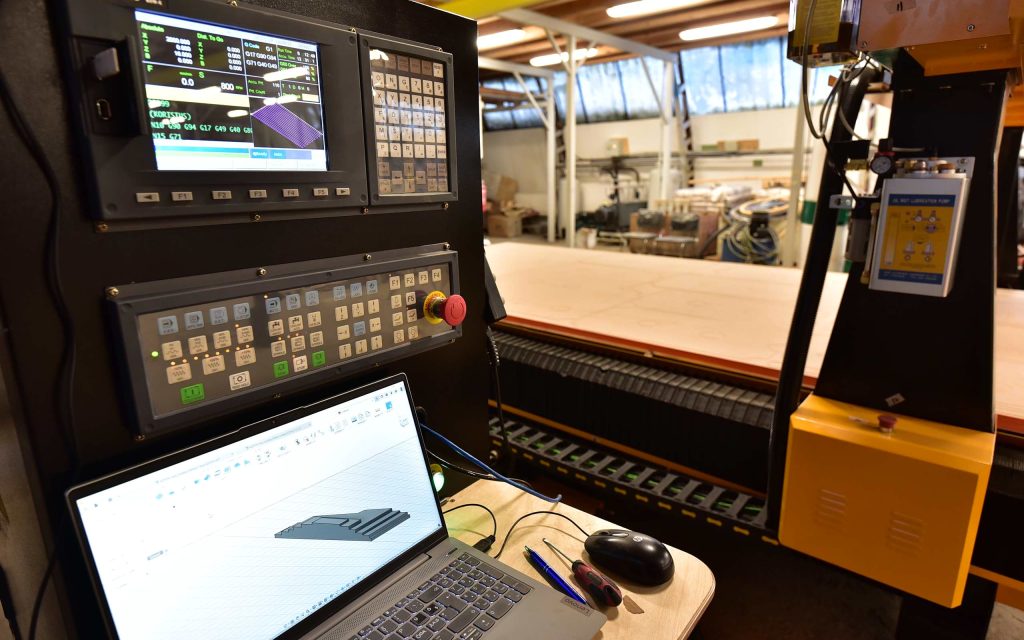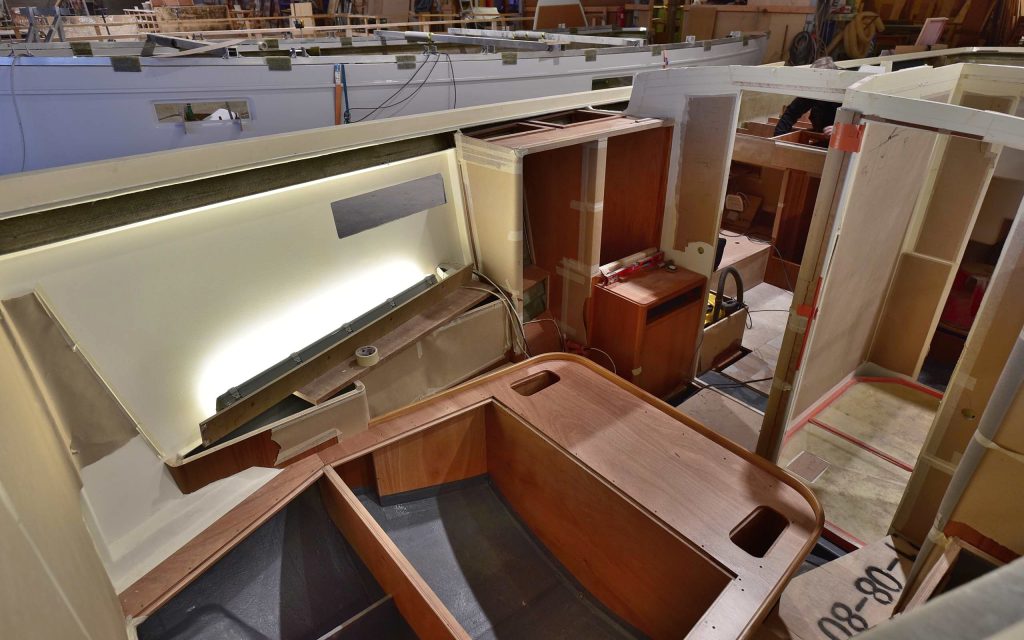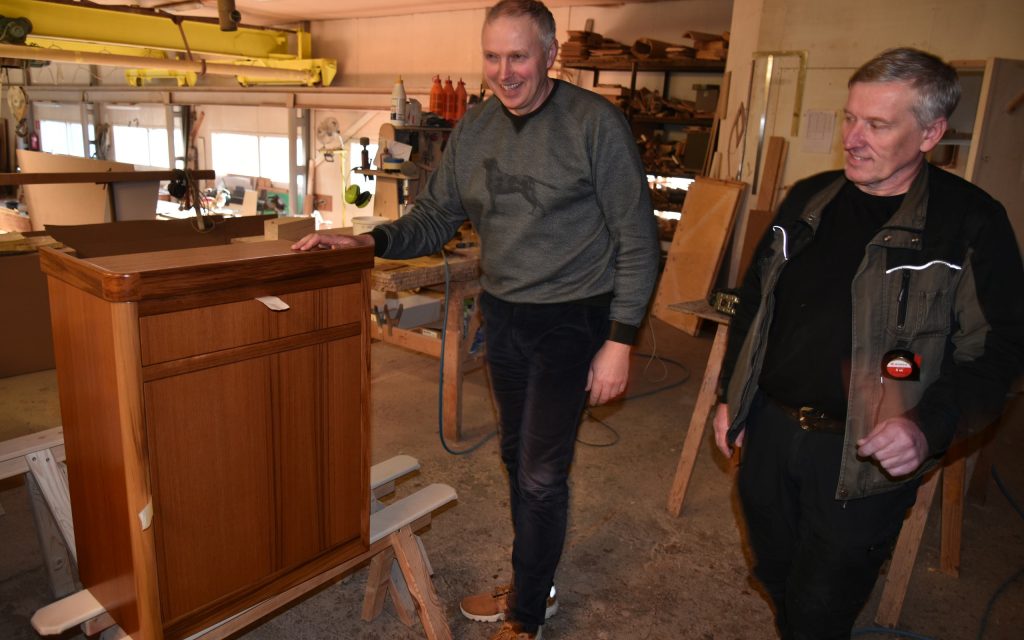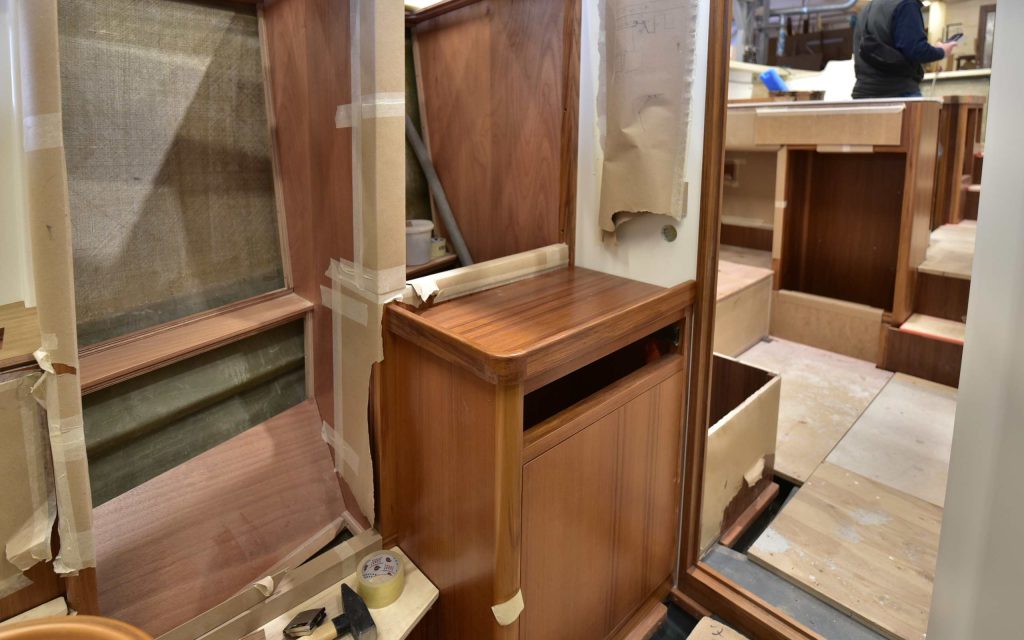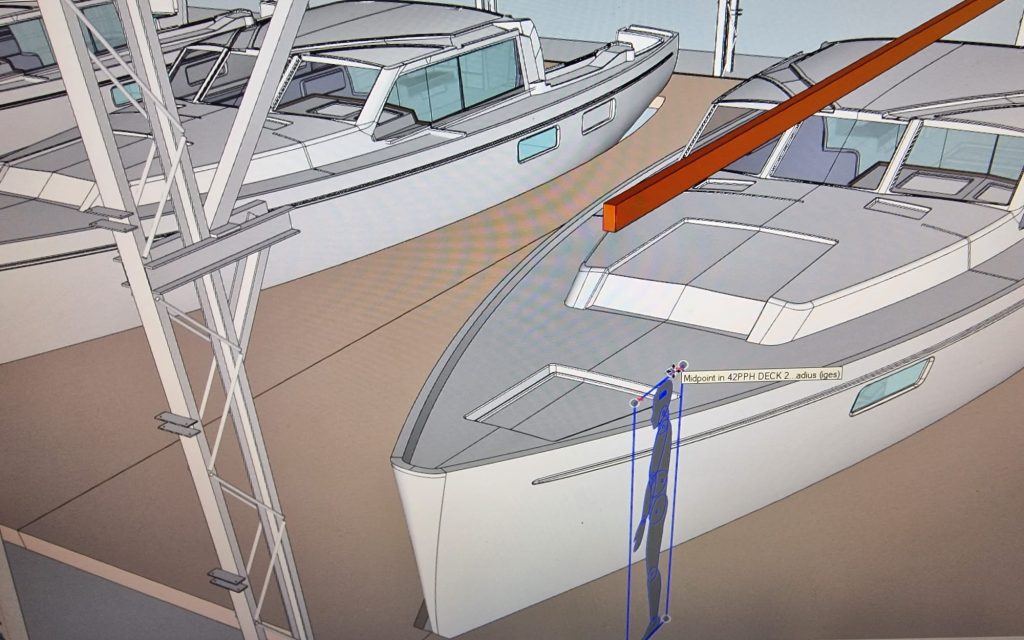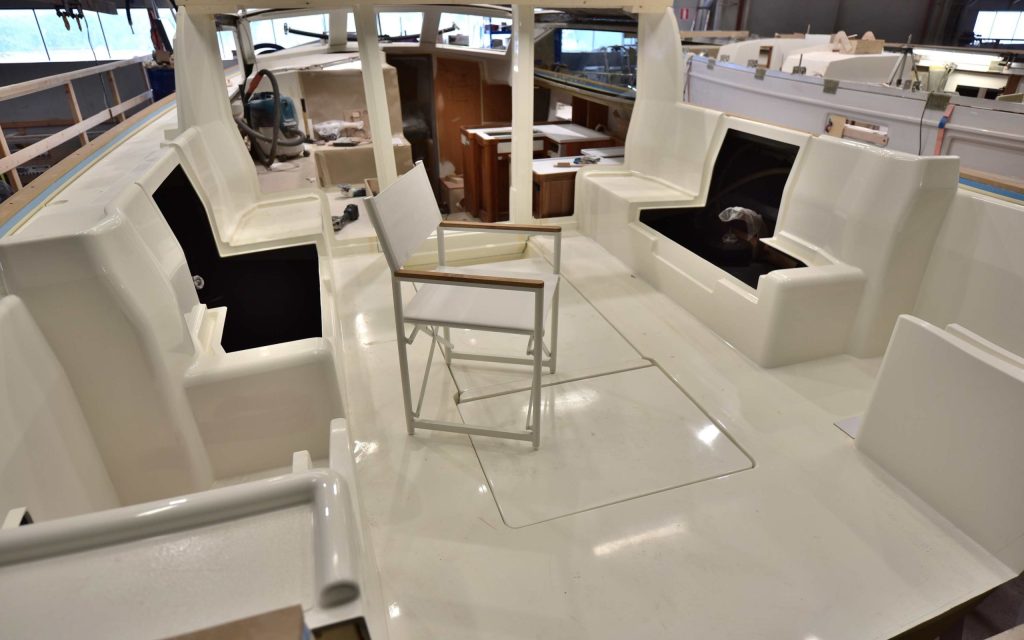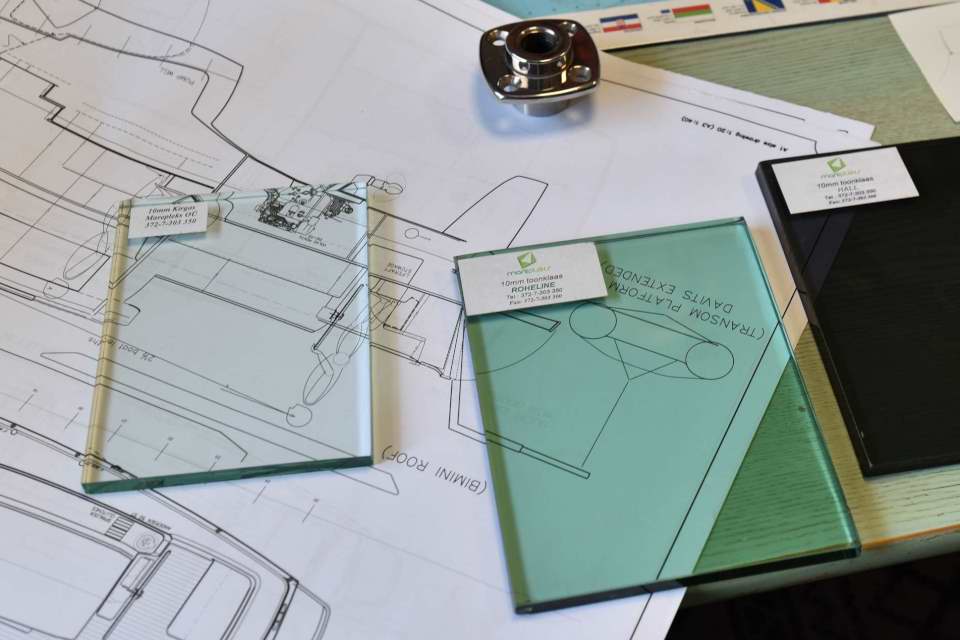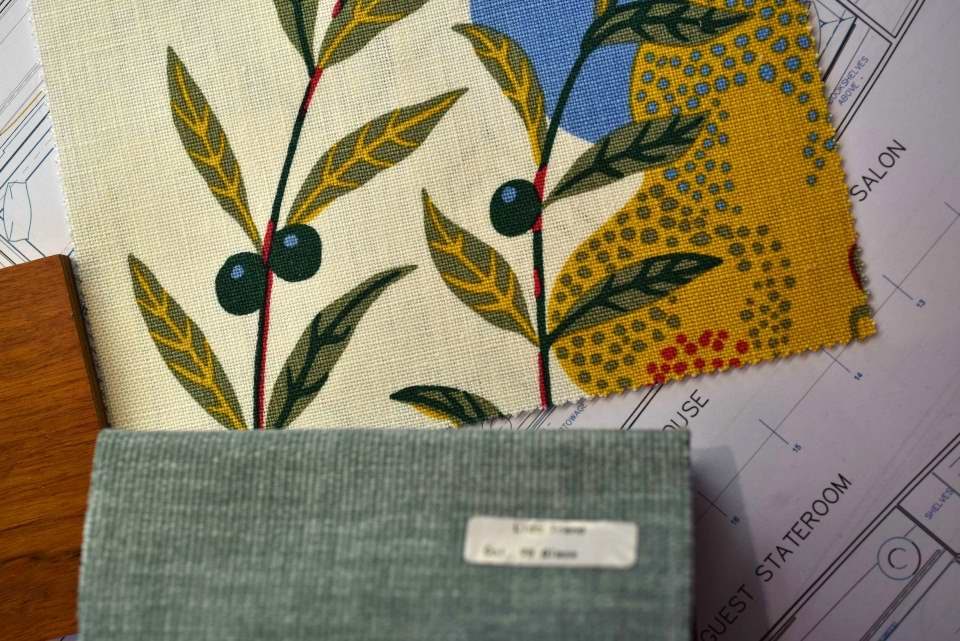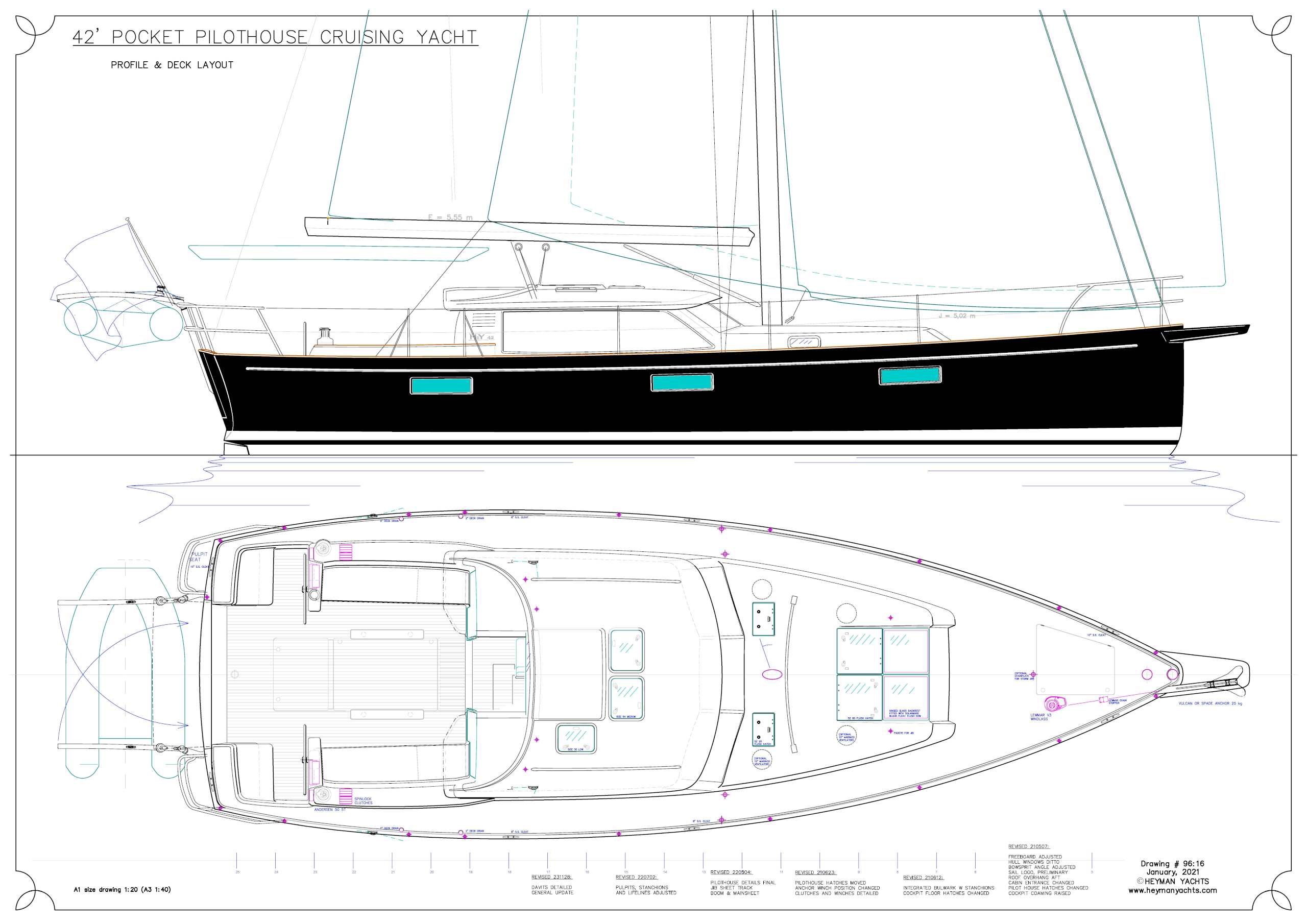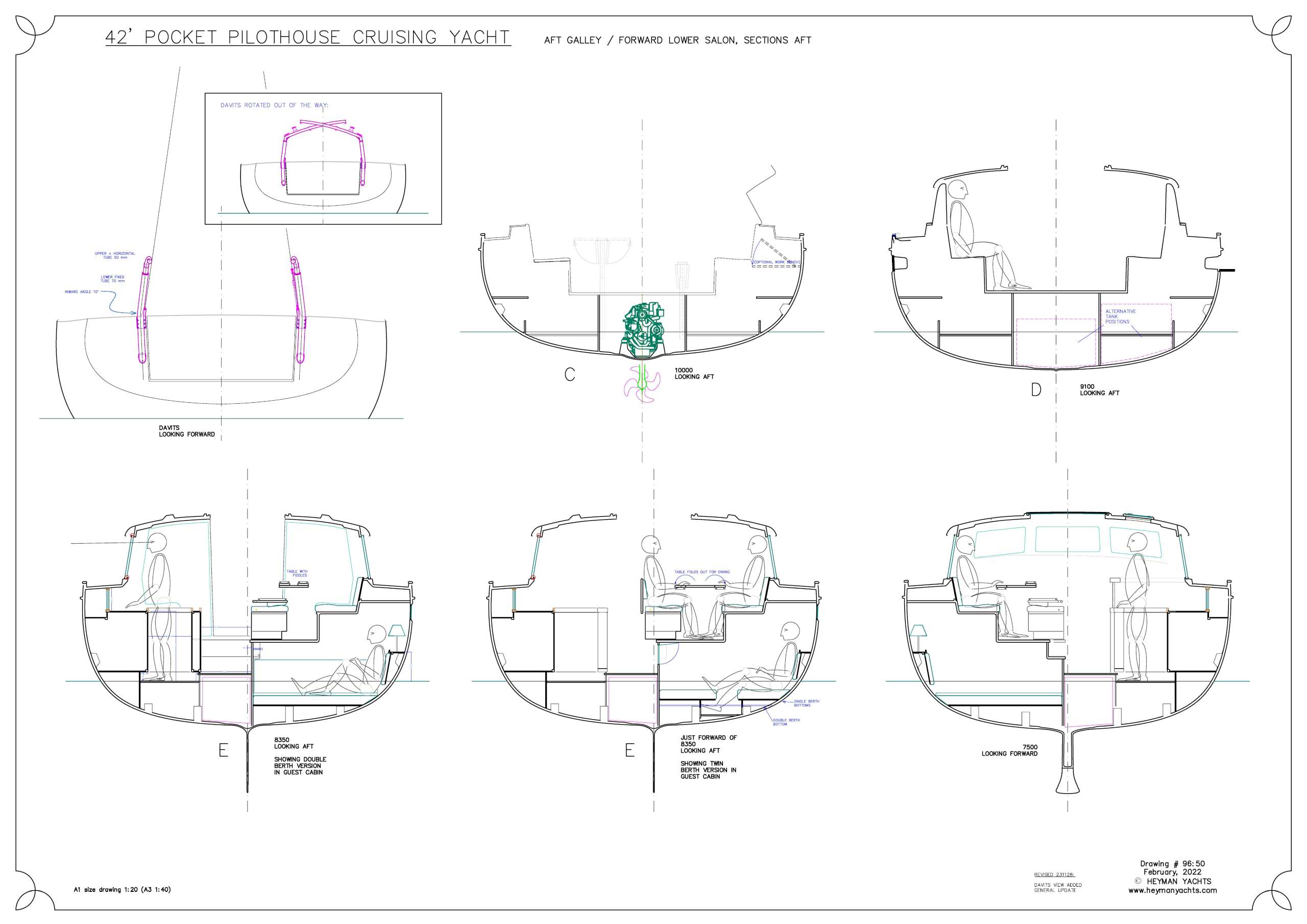PPH number one finds her way into the right element
SEE HER SAILING – VIDEO AT THE BOTTOM OF THE PAGE!
Launching in Tallinn, Estonia, August 2023:
DESIGNER’S NOTES:
The PPH is the first of its kind. There are other yachts which may be slightly reminiscent, at least in theory. But in basic proportions, in function and in character there is no other like her.
One of the most important goals of a cruising yacht design is to make a competent yacht with excellent performance, eager to cover distances. A nimble yacht with distinct handling, using well-established, durable technology.
But in addition , this new design had to offer a level of comfort matched by few, if any, boats under 55 ft.
In order to get there, obviously she had to be different.
In fact, even the concept behind the yacht had to be different.
The idea was about being on the water, with a view of the surroundings, under the blue sky and close to nature. Not only when you are in the cockpit, but also inside the yacht.
So, what is she? A sailing yacht or a beach house?
“A YACHT WITH A VIEW”
After years of design work, development and building at one of the finest yards – finally – one day she is on the water and you hop on board!
Now, this is even more strange:
In that moment, it all falls in place and feels like the most natural thing.
You are indoors and outdoors at the same time.
And it feels like there has never been any other kind of boat.
DIFFERENT CONCEPT, HOW?
-
She is open:
From the stern platform and the cockpit, through the main cabin and forward salon, she flows together into one huge space.
-
She is generous:
For a 42’ cruising yacht, the PPH has more elbow room than most. Partly because she has fewer cabins, and a different layout altogether. You will never feel confined “down below”.
-
She is made for walking:
Arriving in your dinghy, you step onboard the folded transom, walk through the cockpit and into the galley with one grocery bag in each hand.
And this ‘almost-one level’ continues all the way forward into the bathroom and cabins.
A CLEAN DECK
With all manoeuvring handled from the cockpit there is rarely any need to go on deck but when you do, it is safe and easy to move about.
The shrouds are placed at a good distance allowing an easy passage forward and there is a solid handhold on top of the roof.
No ropes on deck or coachroof and nothing to stumble upon.
With a good-sized bulwark, the deck is inviting and lovely.
On foredeck, there is a nice option – raise the solar panels and they will serve as backrests. Laying out the fitted cushions, this spot turns into two lounger chairs – a nice place to rest after a swim maybe, or watch the sun setting over your anchorage.
COCKPIT
The cockpit is one of the clues to what makes the PPH so special.
Controlling the PPH from the helmsman’s position is easy. All lines are managed by the electric Andersen winches via a set of clutches, with mainsheet and self-tacking jib sheets handled from both port and starboard.
All controls are centred around the port and starboard side dashboards – the electric Selden furling gear, the engine controls, bow thruster, compass, instruments and plotters.
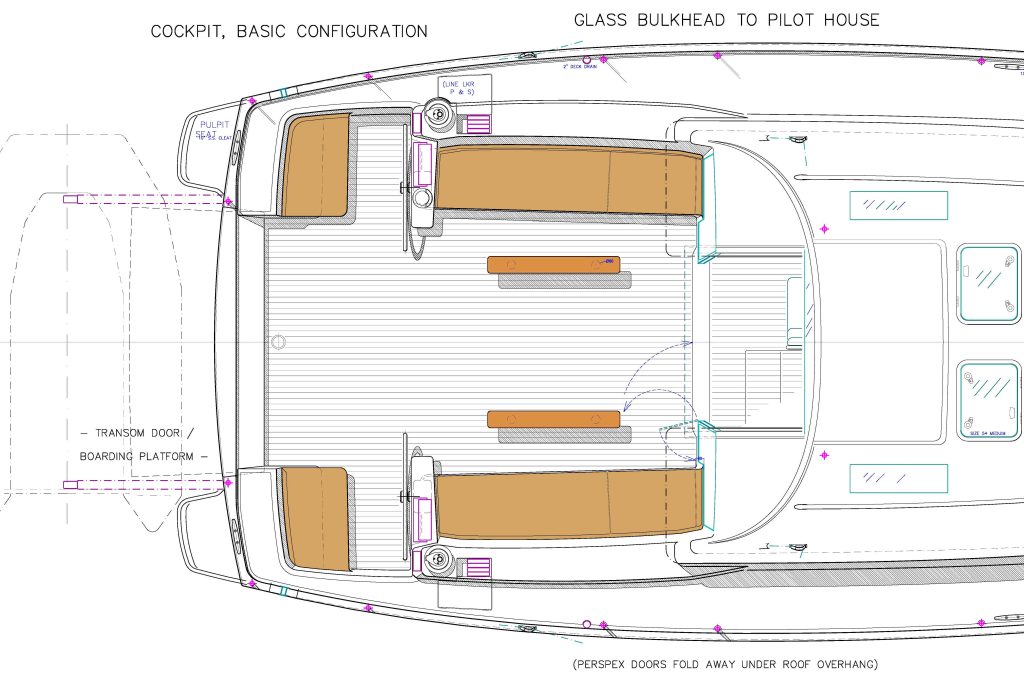
When sailing you can sit in either of the two helmsman’s seats, stand behind either of the wheels (with or without the raised floor in position), or half-sit on the side decks.
Then, of course you can engage the autopilot and lean back in the aft pulpit seat…
Visibility forward is not as perfect as in a racing boat with a shallow cockpit and a low coachroof. But it is still good enough, through the windows, above the pilothouse roof or along its sides.
(For a more detailed view when approaching a low jetty or picking up a mooring there is an option of a mast camera with its image shown on the plotter – this would in fact be a great help in many boats)
IN PORT
The cockpit is the part of any sailboat where most of us will spend our waking time and the cockpit in the PPH is designed to offer so much more… this cockpit is something of a front porch where you will be able to move around and find your favourite spot, at any time of the day.
You may want to sit in the sun, to read your book out of the wind or enjoy a coffee in the shadow.
You can get together in the evening with friends, and the vast floor space offers room for a few folding deck chairs around one of the tables. Or both of them.
With a bimini in place, you can keep the heat out, or be protected from a shower.
For the morning swim or kids play, fold out the stern platform and the pool ladder. The platform extends the cockpit floor, at the same level, and the combined area is huge by any account, at 12 square metres.
(In the picture above there is another detail of some interest: The aftermost hull windows on each side are made as blind glass “windows” with a black inside. But as an option, these can be made as footsteps which fold out of the hull side to help getting on board if you are tide alongside a low jetty)
THE FREEDOM OF HAVING A DINGHY
A dinghy offers an ultimate degree of freedom – even at anchor, it will still be easy to go ashore almost anywhere for a walk or for shopping. Still, in many boats hopping in the dinghy or getting back onboard is often something of a challenge.
In the PPH, this is easy with the help of ingenious davits that hold the dinghy high up and close to the transom, then when the dinghy is lowered it automatically moves aft to clear the folded stern platform:

With the dinghy just aft of the stern platform it could not be easier to move in or out:
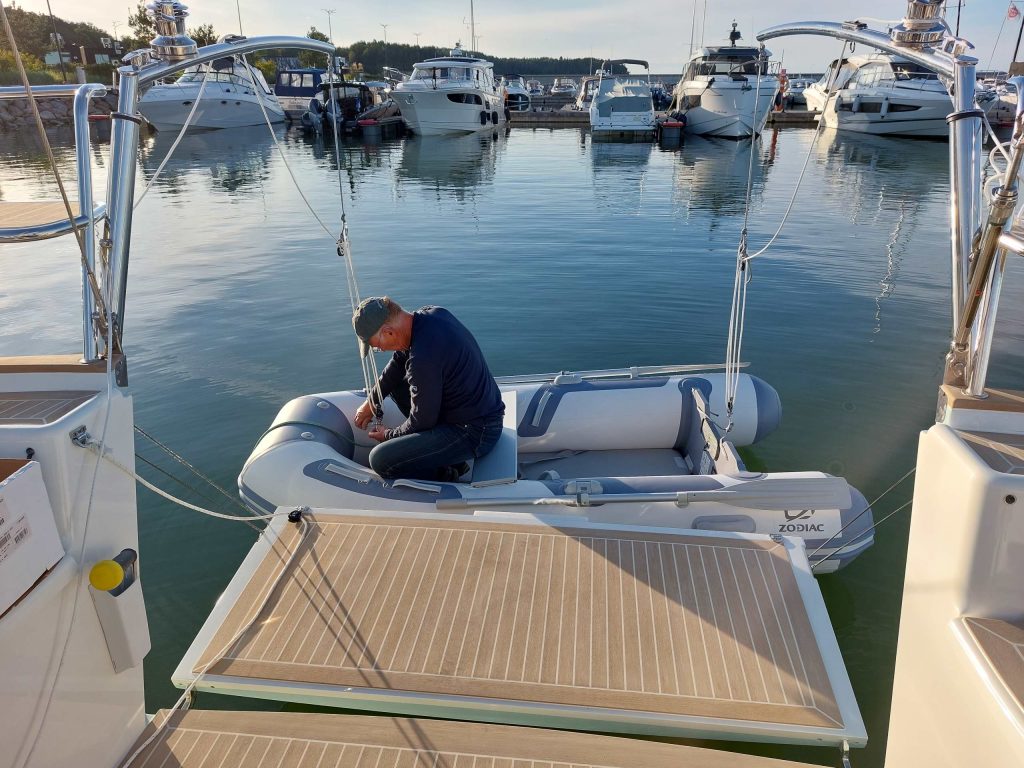
SO, HOW BIG IS SHE?
The PPH is conceived for two people living on board in comfort, like a studio on the waterfront or a small summer house.
In addition, there is space also for friends staying for a week or two, or for children or grandchildren on vacation.
In sports car terms, she is a 2 + 2:
A boat with ample room for kids or guests – without any real compromise. But, first of all, built for two people, with a level of comfort you will not find in any other yacht of her size.
GOING INSIDE
The outside and inside of the PPH are separated by a solid glass bulkhead. The interior is dry and silent, in part thanks to the big side and front windows being insulated.
The heart of the yacht is the galley, with an all-around view and room for two to cook together:
To the right of the stove (gas or electric) there is a fridge and freezer. In PPH hull #1 this is split between a top-loaded fridge/freezer set into the worktop, and an easy-to-access pull-out fridge:
When washing up, the dishes can be left to dry in the dish drainer. Small plates, glasses or cups will fit under the closed lid.
There is a small L-shaped shelf above for paraphernalia. The woodwork throughout the yacht is first-class; teak in this first hull – mahogany is standard.
Under sail, the ‘wings’ in the galley are ideal for bracing yourself securely:
MAIN CABIN
Opposite the galley, there is a bureau with chart drawers which does double duty as a pull-out seat.
When stowed in its idle position, its folded backrest serves as a relief table for binoculars, phones and books, and the edge closest to the galley forms a handhold:
FORWARD LOUNGE
There is a more private corner forward with a sofa, a bookshelf, reading lights and a coffee table. The sofa is nice for an afternoon nap but also converts into a proper spare bed.
On the opposite bulkhead there is room for a television, above the bureau:
The bureau is special – we call it ‘the USB Bureau’. Inside, every crew member has her or his own space for things like phone, sunglasses, wallet, lipstick or sun lotion.
Inside each space there is a USB outlet for charging:
A SMALL GUEST ROOM
This room is found if you enter the door just aft of the USB bureau.
A big double bed (1,60 by 2,05 m) with a head board, reading lamps, a few shelves, a small bureau and a somewhat limited clothes locker. Plus a good seat and a couple of opening hatches:
OWNER’S STATE ROOM
The owner’s quarters are most unusual.
The normal layout for a forward stateroom in a boat of this size would be either a V-shaped bed with feet forward, or a double turned the right way but with limited width at the forward end where you are expected to sleep.
The double bed in the PPH is 1,60 metres wide all the way forward, fitted with a headboard. Being turned ‘the right way’, this kind of geometry is unique but will be perceived as the most natural thing (we believe very few people would go to sleep at home with their feet against the wall – so why do it in a boat?)
One of the initial drawings showing a cross-section of the forward stateroom looking forward:
So, let’s see it in real life. On entering, there are two big hanging lockers and a bureau to starboard plus another hanging locker to port, all 60 cm (2 ft.) wide:
Up forward, there are proper bedside tables, fitted with little lockers for your more precious belongings. Under the foot of the bed are big clothes drawers:
Half-sitting in bed, you will be able to look out the hull windows and, if the door is open, you can see all the way through the boat. To port is the door to the bathroom:
A view of the bathroom. The shower is behind glass doors at the forward end, with space for a washing machine to the far left, around the corner of the half-bulkhead:
HIGH AND LOW LATITUDES
Given the basic idea behind the PPH, she is the perfect yacht for living on board also during early or late season. Her pilot house side and forward windows are double glazed to protect against the cold and to prevent condensation. For sailing in wintertime, a heating system keeps the yacht interior warm and dry.
Both hull and deck are made using infusion technology and a high proportion of multidirectional rovings, with vinylester in the hull, making for an exceptionally strong structure. In addition, both hull and deck are built using a Divinycell core to ensure perfect insulation. Not only against the winter cold, but also against the summer heat.
For hot climates, a bimini is advised, together with sun shades for windows and hatches. AC is offered as an option.
UNDER SAIL
Getting under sail is a simple matter of unfurling the sails at the push of a button. The helmsperson will be able to handle the PPH single handed, and all is within easy reach. The winches, the under-deck jib furling and the in-mast Selden mainsail furling are all electric as standard.
A code 0 is offered but such a sail is often too much to handle for a short-handed crew. Instead, this sail is permanently mounted on an outer headstay, and just like the self-tacking jib it is furled by an under-deck electric furler. This sail will be so different from an ordinary Code 0 in practical use that we renamed it, instead using the classic term ‘reacher’. On an open reach, the sheet can be led via the end of the main boom for a more optimal shape.
One of the sail plans above shows a carbon rig version with slightly different proportions and slab reefing, designed to navigate also the Intracoastal Waterways (ICW) of the US East Coast.
(Open in new tab to see drawings in higher resolution!)
Sailing speed will often be more than 7 knots to windward and she will average around 8 on a reach, with top speeds at more than 8 ½ knots. Sailing alongside other cruising yachts she will hold her own. The addition of a gennaker, hoisted from the bow sprit, will ensure good speed also in the lightest of winds.
POWER
Under her 57 hp Yanmar engine, the PPH will run quietly at up to just under 8 knots cruising speed, with more power in reserve. The saildrive is fitted with a folding bronze propeller for efficiency both under sail and power, with even more high-class Flexofold or Gori options. The Sleipner bow thruster is a standard feature and will offer control in tight quarters, while a stern thruster is optional.
Alternatively, the yacht can be fitted with an electric drivetrain, with Lithium batteries charged by solar power or shore power and backed up by a silent genset to increase the range.
HULL & KEEL
The PPH’s design is based on an efficient cruising sailboat hull. Her waterline is almost the full hull length, and special attention has been given to her displacement distribution and the shape of her bow, both above and below the waterline.
The hull shape takes full advantage of recent research at Chalmers University of Technology where 3 different racing 41′ hulls of our design were tested, using both CFD (computational fluid dynamics), followed by tank testing. This study is rare because focus was on the added resistance in waves, where a sailboat’s performance depends to a great extent on the shape of the bow. Until recently, performance in waves has not been possible to investigate using CFD.
To be clear, this research did not take as its starting point the actual 42′ PPH hull but her design was based on our conclusions from the 41′ racing hulls used in the study.
As a result of her carefully defined hull shape, the PPH is manoeuvrable, with controlled and civilised steering at all times.
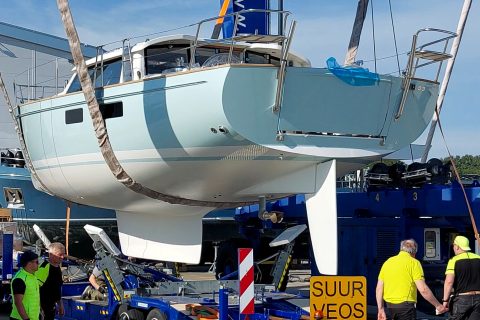
PPH underwater body
In order to be able to explore shallow waters and to drop the anchor in the most protected coves, the draft is only 1, 48 m (less than 5 ft.) deep.
The PPH is built as a long fin keel with efficient foil sections and, at the bottom, a distinctive bulb shape with a very low centre of gravity.
The limited draft is more than compensated by the much longer fin keel and the concept works well on all points of sailing.
In addition, an optional keel /centerboard solution is offered. The centerboard is hidden entirely inside the bulb and is remotely controlled (with a manual winch override) but – this is important – it is not a lifting keel, it weighs relatively little and its function is only to reduce leeway. With the board down, the draft increases to 3,02 m (close to 10 ft.):
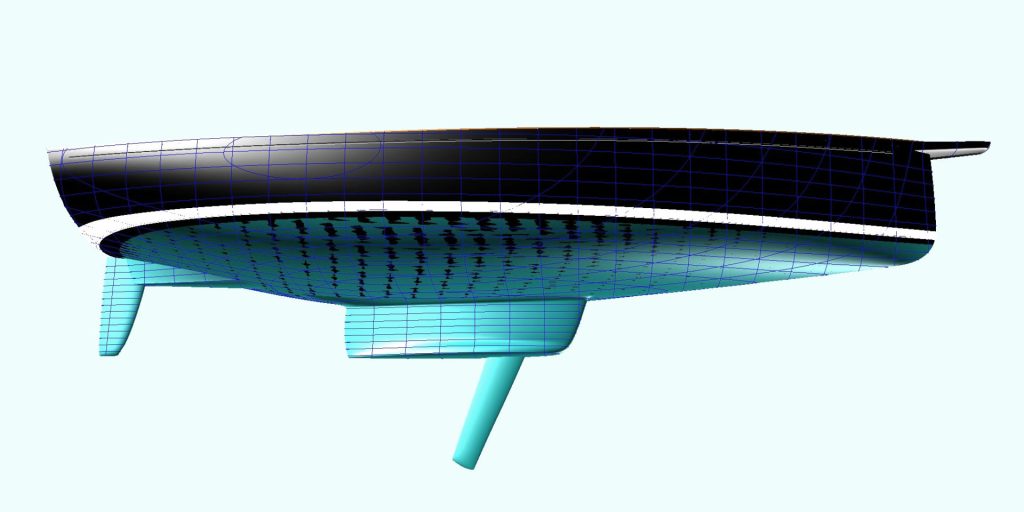
PPH 42′ centerboard, illustration
The centerboard is made of solid glass and, like the keel itself, it is of course carefully foil shaped.
EXTERIOR DESIGN
There is good and bad design, both in ‘classic’ yachts and in ‘modern’ yachts.
Still, it is not about classic versus modern. It could be argued that good design is more about finding an attitude which goes hand in hand with what the yacht is supposed to do. And, at best, with an honest and gentle personality.
So what about the PPH? The purpose of her design is a yacht which knows her way and takes care of those on board, rather than the other way around. I hope she conveys this feeling, and maybe with some sort of purposeful, determined ‘workboat’ character – you be the judge!
QUALITY
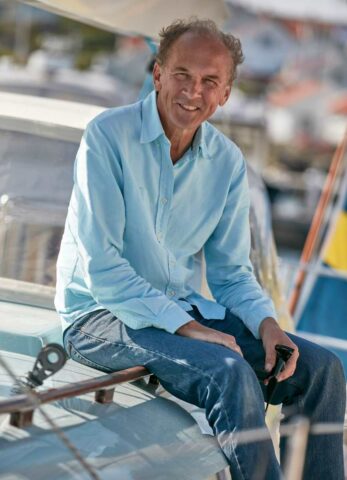
Image (c) Nico Krauss
The 42’ PPH has been developed over the course of several years by award-winning yacht designer Gabriel Heyman and colleagues, trying concepts, scrutinizing ideas, testing alternative solutions and fine-tuning the design, inside and out.
BUILDERS
The yacht is built to order by one of the finest and most experienced boat builders in Northern Europe, Ridas Yacht, near Tallinn, Estonia.
Images are from the yard’s two latest projects, a new 115′ aluminium yacht built throughout to Lloyd’s 100 A1 class, followed by the PPH.
From the day that an agreement was made with Ridas to build the PPH, work started with the yard’s own 3D-modeling of all parts, all volumes and all installations in the PPH. Every single detail is fitted with the highest precision.
Still, the building time is long and, as a result, the yard’s capacity is limited to 5 or 6 yachts built per year.
DIMENSIONS:
Overall length 13,52 m 44′ 4″ (including bowsprit)
Length on deck 12,66 m 41′ 6″
Waterline length 11,83 m 38′ 10″
Beam 4,30 m 14′ 1″
Draft 1,48 m 4′ 10″
Draft w’ centreboard 3,02 m 9′ 11″
Displacement 11 400 kgs 25 000 lbs
Sail Area 93 sq.m. 1000 sq.ft.
ENGINE
Yanmar 4JH 57 Volvo / Penta D2-75, sail drive
– or –
Electric Sail Drive 21 kW, lithium batteries, solar panels + genset
INTERIOR DÉCOR
Apart from choices of wood, the interior upholstery can be chosen from a range of high quality, water-repellent fabrics by Nevotex and Svenskt Tenn.
The PPH can be delivered with china from Iittala in Finland, glassware from Arcoroc.
DRAWINGS
(Use the arrows to scroll through the different drawings /
+ right-click to save drawings or open high-resolution versions in new tab!)
Please contact us for larger size drawings or other requests, see below!
Design #96 ©Heyman Yachts 2023
VIDEO: DELIVERY FROM TALLINN TO STOCKHOLM / September, 2023
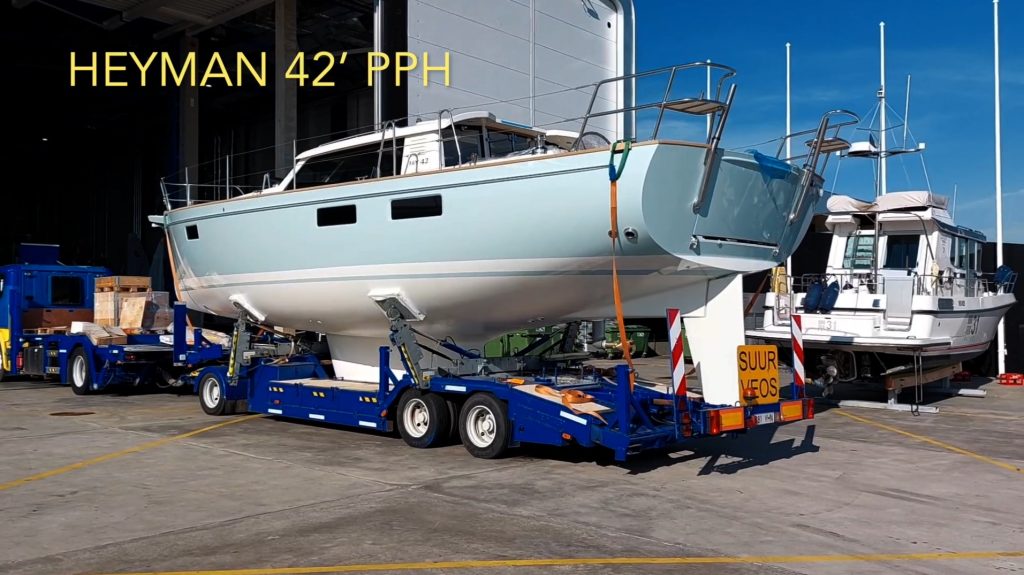
PPH #1, Launching & Delivery
SPECIFICATIONS AND BASE PRICE
The PPH’s specifications include an unusually complete list of items you would expect on a first-class yacht of this kind; things like a folding bronze propeller, the Sleipner bowthruster, B & G instruments and Ritchie compass, the Seldén rig with in-mast electric furling and electric under deck furling for the jib, the Selden self-tacking arrangement, electric Andersen winches, a Spade anchor with calibrated chain and the Lewmar windlass plus a high pressure pump on foredeck, a cockpit shower, Flexiteek in cockpit, nice beds complete with mattress pads, big tank volumes, water heater, a generous Victron battery bank, Victron charger and big inverter.
In addition, there are of course numerous options, like the twin-headstay rig, the centreboard, electric propulsion, AC, heating, bimini, davits and much more.
Download specifications here: Heyman 42 PPH specifications 241205
For a price quote, please write or call!
QUESTIONS, CONTACT
We will be happy to answer any (or most) questions, so please ask!
- Pia Hallonsten, pia.hallonsten@heymanyachts.com, +46 705 353 291
- Anders Hemgren, anders@hemgren.se, +46 705 113 057
- United States : Joe Brase, joebrase@gmail.com, +1 (803) 493-0913
- Gabriel Heyman, info@heymanyachts.com, +46 707 790 003
Or just click the envelope below.
Note: This page may be updated without notice
(c) Heyman Yachts AB / Heyman Yachts International AB, February 2025
